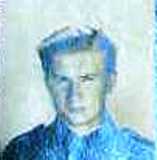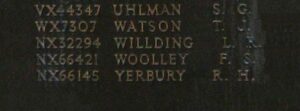Gowerton Comprehensive School opened on 5 October 1896 in Talbot Street as a co-educational Intermediate school under the Welsh Intermediate Education Act 1889. It was known locally as Gowerton County School. During May 1940 the school became a boys’ grammar school when a girls’ grammar school opened on Cecil Road. The present school was created in 1973 from the merger of Gowerton Girls’ Grammar School and Gowerton Boys’ Grammar School and in 1987 the school was centralised on the former girls Cecil Road site. A large number of former students from the school served during both world wars, with some gaining gallantry awards, and those who fell during both conflicts are commemorated on two war memorials which are located within the school. The school holds a bound book which commemorates its pupils who fell during World War Two, but currently do not hold anything regarding those who fell during the Great War.
The Great War, 1914-1918
BWRDD COFFA A GODWYD GAN EU
CWMDEITHION YN YR YSGOL HON
DRUD Y RHAI A GOLLODD EU BYWYDYN
Y RHYFEL MAWR 1914-1918
HEDDWCH I’W LLWCH
Glyndwr Levi Andrews, Captain, Royal Welsh Fusiliers. Glyndwr was born in Cockett in 1888, the son of Thomas and Elizabeth Andrews. His father was originally from St Clears and was a school attendance officer. Educated at Gowerton, and at the Normal College, Bangor, Glyndwr became a teacher at Penllergaer prior to the war. He enlisted in August 1914 into the 13th Battalion, Royal Welsh Fusiliers, and was soon commissioned as a second lieutenant and by 14 January 1915 had been promoted Captain. He embarked for France with the 19th Battalion, Royal Welsh Fusiliers, which was attached to the 40th (Bantam) Division in June 1916. Within months of reaching the front, he became ill and was invalided home suffering from shell-shock and trench fever. After recuperating at a training camp in England for several months, he returned to France with the rank of Captain, and was attached to the 16th Battalion, Royal Welsh Fusiliers, which was attached to the 38th (Welsh) Division. After moving to the Somme in March 1918 the division remained in the Aveluy sector until launching its assault across the flooded Ancre valley on 21 August 1918. The 16th Royal Welsh Fusiliers made their attack at 01.00 on 26 August, capturing the village of La Boisselle, and on the following day assaulted and captured Contalmaison. It remained in positions around here for the remainder of the 25th, preparing for an assault on the following morning against Longueval, and skirted around Mametz Wood, the scene of such carnage two years earlier. Longueval and the adjacent Delville Wood were held in force by the Germans, and heavy fighting continued throughout the 26th. Glyndwr was killed while leading his company from Mametz Wood towards Longueval that day. The 30-year-old was buried by his men on the battlefield, besides two fellow officers and a number of men of the battalion who were killed in the same assault. The graves were re-interred in Caterpillar Valley Cemetery, Longueval, France after the war, and Glyndwr now lies in grave reference VI. B. 15. (The CWGC show his death as 21 August 1918, but this is incorrect, as the battalion war diary proves otherwise).

John Benson Bennett, Second Lieutenant, Rifle Brigade. John was the son of Richard Francis Bennett and Mary Alice Bennett (nee Benson), of High Street, Gorseinon. After leaving Gowerton School, he became a student teacher at Penllergaer, then decided to enter Cardiff University to gain his degree, obtaining his BSc. He played cricket and rugby for Gorseinon prior to enlisting into the Welsh Regiment, and served in France with the 10th Battalion, Welsh Regiment, which was attached to the 38th (Welsh) Division. A promising soldier, he gained his commission into the Welsh Regiment on 12 June 1917 and was posted to the 3rd Battalion, Rifle Brigade, which was attached to 17 Brigade, 24th Division. Following the closure of the Passchendaele offensive in 1917, the 24th Division was moved to the Bullecourt sector and took part in heavy fighting following the launching of the German spring offensive, which was launched on 21 March 1918. The British line collapsed under the assault and over the coming days the British retreated from their positions facing the Hindenburg Line towards Bapaume. John’s battalion came under heavy attack on 28 March 1918 whilst attempting to stem the German advance, and John was shot in the hip. Lying on the floor in agony, and unable to walk, he called out for help and a fellow officer rushed out to haul him to safety, with the help of some other men. While dragging him back to relative safety, another bullet hit John, killing him instantly. Due to the severity of the situation, his body was left on the battlefield, and as a result John, who was 22 years old, has no known grave and is commemorated on the Pozieres Memorial, France. His brother, Robert, had died in 1916.
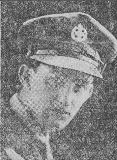
Robert Vivian Bennett, Sapper, 986, Royal Engineers. Robert was the son of Richard Francis Bennett and Mary Alice Bennett (née Benson), of High Street, Gorseinon. After leaving Gowerton School he worked as a Pattern Maker prior to enlisting at Llanelli on 29 October 1915 into the 1/1st Welsh Field Company, Royal Engineers, which was attached to the 53rd (Welsh) Division, and joined the unit in Egypt on 10 June 1916, following its withdrawal from Gallipoli. Robert became ill and was hospitalised in Cairo, and a telegraph was sent to his parents stating that he was suffering from a diseased hip. He died of tuberculosis in hospital on 26 November 1916, aged 21, and is buried at Cairo War Memorial Cemetery, Egypt in Grave Ref. F.165. His brother, John, was killed in 1916.
Wilfrid Bevan, Second Lieutenant, Royal Flying Corps. Wilfred was the son of John and Rachel Bevan, of 2, Chester Villas, Gowerton. After leaving Gowerton School, he enlisted into the 28th Battalion, London Regiment (Artist’s Rifles). Wilfrid then volunteered to train as a pilot, and after gaining his certificate joined the 20th Squadron, Royal Flying Corps in France. The squadron was a fighter-reconnaissance unit, equipped with the Bristol F2b two-seater fighter. At 11.25 on 3 December 1917 Wilfrid took off on patrol in Bristol F2b A7141, with Second Lieutenant Francis Beresford Gloster as his observer. He came into contact with German aircraft north of Hollebeke, and at 12.10 was shot down. No trace of the aircraft was found, so Wilfrid and Francis, who have no known graves, are commemorated on the Arras Flying Services Memorial, France.
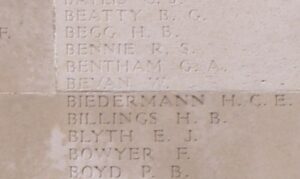
Donald Hamilton Davie, Private, S/12007, Cameron Highlanders. Donald was one of ten children of George and Susan Davie, of Normanhurst, Langland-road, Mumbles. When he left Gowerton School he begun working in his father’s coal business, and travelled to Inverness to enlist into the 5th Battalion, Cameron Highlanders at the outbreak of war. The battalion was attached to 26 Brigade, 9th (Scottish) Division and embarked for France on 10 May 1915, moving to the Loos sector, just after the end of the Neuve Chapelle offensive. Sir John French, the commander-in-chief, had planned a large-scale offensive at Loos, which was to be launched following an artillery barrage and a massive release of chlorine gas. Facing the 9th (Scottish) Division was a strongly defended German position known as the Dump, which was a five-metre-high slag heap, which had been strengthened by a system of bunkers and dug-outs, and was also defended from a frontal assault by a formidable position known as the Hohenzollern Redoubt. Connecting the redoubt to the main line to its rear were two trenches known as Big Willie to the south and Little Willie to the north. It was the Brigades task to take the redoubt and then continue on to Fosse 8, a coal pit which had been turned into another defensive position. The role of the 5th Cameron Highlanders, in which Donald served, was to then follow up any successful attack and move towards Haisnes. Although the gas release failed, due to the wind, the initial assault gained some success, and at 06.40 the Cameron’s advanced behind a smoke screen and passed through Little Willie reaching Fosse Trench by 07.10. However, the attack to the left had failed and throughout the day the Germans launched a series of counter-attacks. Donald was killed at some time during the day, 25 September 1915. The 20-year-old has no known grave, and is commemorated on panels 119-124 of the Loos Memorial, France.
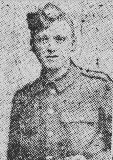
David Harold Davies, Second Lieutenant, Wiltshire Regiment. David was the son of Abel Christmas Davies and Mary Catherine Davies, of The Woodland, Gowerton. He enlisted into the 28th Battalion, London Regiment (Artists Rifles), and served in France until being commissioned into the 1st Battalion, Wiltshire Regiment on 25 February 1918. The battalion was attached at the time to 7 Brigade, 25th Division, and had moved to the Bullecourt sector following the closing down of the Passchendaele offensive in the winter of 1917. The division was one of several which had the misfortune to be caught up in all three major German offensives of spring 1918, moving to the Lys sector to rebuild following heavy losses on the Somme from 21 March 1918; being caught up in the German Lys offensive on 9 April; and then moving to the Champagne sector to rebuild and being caught up in the German Aisne offensive of 26 May. On 27 May 1918 the attack hit them, and during the coming days the Division was virtually annihilated. By 9 June, a decision had been taken to break up what was left of the Division to reinforce other formations and the 1st Wiltshire’s were transferred to 110 Brigade, 21st Division, which had also suffered terrible casualties. The reformed division then moved to the Somme sector, in order to take part in the great offensive which was launched on 21 August 1918. On 30 August the battalion was advancing west of Beaulencourt, and David was sent forwards with a fighting patrol to get in touch with the enemy. The Germans opened heavy machine-gun fire onto the patrol, and David was seen to fall. Unbeknown to his men, he had been wounded and was taken prisoner of war. He died of wounds as a prisoner a week after the Armistice, on 18 November 1918, aged 20 and was buried in Goettingen Military Cemetery. After the war graves in the locality were exhumed and David was re-interred in Niederzwehren Cemetery, Kassel, Germany, in grave VII. B. 4.
John Phillips Davies, Signalman, Wales Z/2297, Royal Naval Volunteer Reserve. John was born on 21 March 1896, the son of Lewis and Mary Ann Davies, of Knoll Avenue, Swansea. He enlisted into the Royal Naval Volunteer Reserve on 30 October 1915, and after a brief period of service with the Royal Naval Division trained at HMS Pembroke I, before spending time aboard the ships HMS Marlborough and HMS Royal Oak. On 9 July 1917 he was posted aboard the light-cruiser HMS Cardiff. She had been launched on 12 April 1917, becoming the flagship of the 6th Light Cruiser Squadron of the Grand Fleet the following month. On 17 November 1917 she was part of a fleet sent to intercept German minesweepers that were operating in the North Sea under the protection of four light cruisers. The Germans laid down a smoke screen after spotting the approaching Royal Navy vessels, but despite limited visibility a fire-fight ensued. Cardiff was hit several times, killing seven crewmen and wounding thirteen, but was only lightly damaged. John, who was 21-years-old, was among the dead. He was buried at sea and is commemorated on panel 25 of the Plymouth Naval Memorial, Devon.
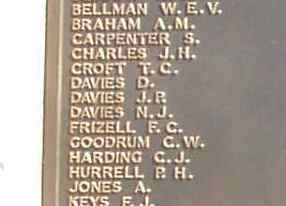
Philip Stanley Edwards, Corporal, 22565, Princess Patricia’s Canadian Light Infantry. Philip was born on 2 August 1893, the son of John and Ruth Edwards, of Morgan’s Terrace, Fforestfach, Swansea. Upon leaving Gowerton School he became a miner, and migrated to Canada from Liverpool on 27 May 1913 with a friend, David Rees. Following the outbreak of war, both men enlisted on 23 September 1914 into the Princess Patricia’s Canadian Light Infantry (Eastern Ontario Regiment), and Philip added two years to his age. By 27 October 1914 the battalion was training at Salisbury and both men were on leave the following month, visiting family in Fforestfach. In early November, the Regiment moved to Winchester to join 80 Brigade, 27th Division as a British army unit and landed in France on 21 December 1914, making the PPCLI the first and only Canadian infantry regiment in a theatre of war during 1914. The battalion served for a year with 80 Brigade, and saw heavy fighting during the defence of Ypres, taking a leading part in The Battle of Frezenberg in May 1915. Philip wrote a short letter home to his parents just prior to the battle: “I have had my desire in getting to the front, but I must say it is not much like what I thought it would be. I have seen death in its most terrible form, and a man gets to feel a contempt for death. I could not describe what it means to be under fire, as a man has no time to think much. He simply has to keep low, and see he doesn’t get left. The shelling is the worst phase of this war; one feels like a rat in a trap when they burst all round him. We have had to stand a lot of shelling here, but our artillery is superior to theirs and soon quiets them. Another thing about this war which makes it unique is that the battle never ends. We go to the trenches and then back in reserve, and later in again. We are always under fire. The last trip I had was hell indeed. The trench was almost knee-deep with water, and as it snowed it was terribly cold.” Within weeks he was in hospital as a result of being shot in the thigh on 12 May. When he returned to action some months later he became ill and was again hospitalised for a while. On 22 December 1915 the Regiment transferred to the 7th Brigade of the newly formed 3rd Canadian Division, taking part in the Battle of Mount Sorrel in June 1916 before being transferred to the Somme sector. On 12 August 1916 Philip was promoted Corporal. He was shot in the head during the Canadians assault on Courcelette the following month and was brought by train to the 1st Canadian General Hospital at Rouen, where he died of his wounds on 21 September 1916, aged 23. Philip is buried in Étaples Military Cemetery, France, in grave XVI. A. 3A. He had been a chorister at St. Peter’s Church, Crockett prior to going to Canada, and in August 1917 a memorial plaque was unveiled there to commemorate him.

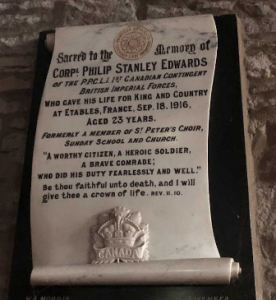
William Richard Field, Signaller, Wales Z/1799, Royal Naval Volunteer Reserve. William was born on 21 July 1898, the son of Richard William and Emma Jane Field, of Somerville Villas, Raven Hill, Swansea. He enlisted into the Royal Naval Volunteer Reserve on 11 August 1915, adding an extra year onto his age because he was too young, and trained at HMS Pembroke I until being posted to HMS Actaeon, the Royal Navy gunnery school at Sheerness, on 6 December 1915. He served aboard the D-class destroyer HMS Cynthia. She was an obsolete ship, which spent the entire war at The Nore Local Flotilla based at Sheerness and was tendered to HMS Actaeon. William drowned after he was swept overboard during a storm whilst in training at Sheerness on 23 February 1916. The 17-year-olds body was never recovered, so he is commemorated on panel 19 of the Plymouth Naval Memorial, Devon.
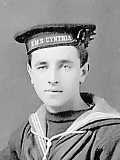
Garnet Griffiths, Private, 766923, London Regiment. Garnet was the son of Samuel John and Mary Griffiths, of Arberth, Dunvant. He was a gifted scholar who had gained several scholarships and awards during his time in education, but left school in 1917, and enlisted into the 1st/28th Battalion, London Regiment (Artists’ Rifles), joining the battalion in France, where it was attached to the 63rd (Royal Naval) Division. Throughout September the division had been taking part in the great offensive and was heading in the direction of the Hindenburg Line. The Artists Rifles, a renowned unit, had been giving the task of capturing the section of Hindenburg Line in their path after a battalion of Fusiliers and Bedford’s had crossed the Canal du Nord, and on the evening of 26 September 1918 left their camp to take up positions in trenches outside Quéant, where the men assembled prior to their advance to a position between Moeuvre and Inchy. The Canadian Corps was to the left, and the Guards Division to the right of the Royal Naval Division. The Artists reached their positions in pitch dark in a heavy rainstorm, and while awaiting zero hour, came under a heavy German artillery barrage, which caused a number of casualties. In the morning news was received that their section of the Canal had been captured, so the Artists set off, crossing the Bapaume to Cambrai road and advancing as far as Anneux. The fighting continued for several days, but the Hindenburg Line was broken by 2 October 1918, and victory was at last in sight for the Allies. Garnet was badly wounded during the assault on the Hindenburg Line, most probably in the artillery barrage which hit his battalion, and he died of his wounds at 38 Casualty Clearing Station on 2 October 1918, aged 18. He is buried in Sunken Road Cemetery, Boisleux-St. Marc, France, in grave III. F. 10.
Joseph Harrop Griffiths, Second Engineer, Mercantile Marine. Joseph was the son of David Griffiths and Charlotte Griffiths (nee Harrop), of Brondeg, Pontarddulais. He was a steam engine builder at Bolton prior to the war and enlisted into the Mercantile Marine, where he knew his skills would prove of value. Joseph was posted aboard the steamer SS Kingsway. On 27 November 1915, Kingsway was steaming from Malta to Huelva in ballast when she was attacked by the German submarine U-33 and sank 20 miles ESE of Cape Bon. Joseph, together with the entire crew, managed to escape the sinking ship and spent 48 hours in lifeboats before being rescued. He returned home on leave some weeks later, before returning to duty and was posted aboard the West Hartlepool registered steamer, SS Daybreak, as her Second Engineer. On 24 December 1917 Daybreak was carrying a cargo of maize and steaming near South Rock Lightship, Strangford Lough, Co Down, when she was struck by a torpedo which had been fired without warning by the German submarine UO87, and blew apart before sinking. Joseph and some other men managed to get into a lifeboat, but that was hit by another torpedo and blew up. Only the Chief Engineer survived the sinking, while 21 men, including Joseph, were lost. Joseph was 23 years old, and is commemorated alongside his shipmates on the Tower Hill Memorial, London. He is commemorated on the Pontarddulais War Memorial.
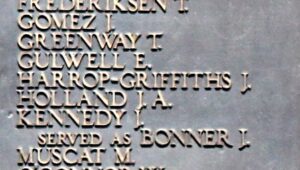
Daniel Idwal Hopkins, Second Lieutenant, South Wales Borderers. Daniel was the son of David and Mary Hopkins, of 13, Oakfield Street, Pontarddulais. He had gained his BSc after graduating from Gowerton School, and took up an appointment at Holyhead County School prior to the war, making his home at Rhosygaer Uchaf. Daniel was commissioned into the South Wales Borderers, and was posted to France to join the 2nd Battalion, which was attached to 87 Brigade, 29th Division. The 2nd SWB had fought in China at the outbreak of war, then at Gallipoli. It then moved to France in 1916, and took part in its first major action in France during the 1916 Somme Offensive, fighting at the Battles of Albert and Le Transloy, suffering heavy casualties. In the spring of 1917 they fought at the Battle of the Scarpe, which was part of the Arras Offensive. On 12 March 1917 the 2nd SWB left Monchiet for Arras and at dusk they left Arras for the line, relieving the 5th Middlesex regiment in positions about two miles west of Monchy-Le-Preux, a strongly defended German held village. On the following day they moved into the front line relieving the 12th West Yorkshire Regiment and the 4th Worcester’s. The battalion had a harrowing time here, notably on 15 April when the Headquarters of D Coy was blown in burying Captain Owen, Lieutenants Lowe, Lewis and Davies. Captain Owen was killed and Lewis and Davies went down with shell shock. The time in the trenches cost the Battalion over 80 men and on the 19th they returned to Arras and rested at Schramm Barracks. Three days later they returned to the front east of Monchy-Le-Preux in readiness to launch an assault against the village at 04.45 on 23 April. The attack met with heavy resistance, and cost the lives of Daniel and five other officers of the battalion. Daniel, who was 27-years-old, has no known grave and is commemorated on bay 6 of the Arras Memorial, France. He is commemorated on war memorials at Pontarddulais and at Holyhead.
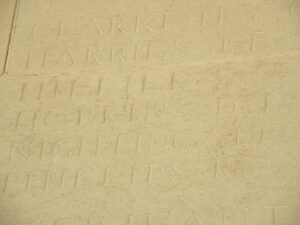
Henry James Isaac, Lance Corporal, C/114, King’s Royal Rifle Corps. Henry was the son of James and Elizabeth Isaac, of 47, Ty-Coch Road, Sketty. He worked as a clerk to the Swansea Harbour Trust prior to enlisting in Swansea on 18 September 1914 and, as a member of the Church Lads Brigade, was posted to the 16th Battalion, King’s Royal Rifle Corps, which was known as the Church Lads Brigade, and was attached to 100 Brigade, 33rd Division. The battalion moved to France with the remainder of the division on 15 November 1915, and spent its first winter in France training in trench warfare in the Cuinchy sector. Henry was among the battalions first casualties when he was killed in action on 2 January 1916, aged 19. His parents had only just received a postcard from him stating that he was about to go into the trenches and had a premonition of his own death. Henry is buried in grave I. H. 20. In Woburn Abbey Cemetery, Cuinchy, France. He is commemorated at Sketty Parish Church.
Owen Jenkins, Lance Corporal, 35538, Machine Gun Corps. Owen was born at Llangennech, the son of John and Mary Jenkins. The family later moved to Cwyn-yr-Awel, Gowerton. Owen was a former Swansea footballer who had gained his BA at Aberystwyth after graduating from Gowerton School, and was a Master at Abertillery prior to the war. He enlisted at Abertillery on 10 December 1915 into the Royal Welsh Fusiliers. On 31 July 1916 Owen sailed to France, and was posted to the 15th Company, Machine Gun Corps, which was attached to the 5th Division. The Division was on the Somme in the summer of 1916, and it was here, during the Battle of Guillemont, that Owen was killed on 5 September 1916, aged 30. He was originally buried on the battlefield, but after the war his grave was exhumed and he was re-interred in Delville Wood Cemetery, Longueval, France, in Grave XXIV. K. 2. His brothers Oswald and Gwyn were also educated at Aberystwyth, and were commissioned as officers during the war, Gwyn being awarded the Military Cross. Owen is commemorated on the Aberystwyth University War Memorial.

William Clyne Jenkins, Private, 260462, Gloucestershire Regiment. William was born in 1898, the eldest son of William and Elizabeth Ann Jenkins, of Sterry House, Gowerton. He left school in 1915 and enlisted at Swansea into the Monmouthshire Regiment. He was posted to France after completing his training and joined the 12th Battalion, Gloucestershire Regiment (Bristol’s Own), which was attached to 95 Brigade, 5th Division and probably joined the battalion as a reinforcement following heavy losses on the Somme in the summer of 1916. On 5 October, after suffering heavy casualties, the Division moved from the Somme to Festubert, where they remained until March 1917. They next saw action at the Battle of Arras, fighting at the Battle of Vimy in April 1917, and the attack on La Coulette. On 3 May they fought in the Third Battle of the Scarpe, and captured Oppy Wood. On 7 September 1917, they were pulled out of the line again, and moved north to join the great offensive in Flanders: Third Ypres, or Passchendaele as it is better known. On 26 September the division fought at the Battle of Polygon Wood, then at Broodseinde and Poelcappelle in September, and on 26 November fought in the Second Battle of Passchendaele. William was wounded at some time, probably at Passchendaele, and was evacuated to the military hospital at Étaples, where he died of his wounds on 14 December 1917, aged 20. He is buried in grave XXXI. D. 24. In Étaples Military Cemetery, France.
Thomas Henry John, Bombardier, 9875, Royal Field Artillery. Thomas was the son of David and Mary Ann John, of Church Street, Gowerton. He enlisted into the Royal Field Artillery early in the war and was posted to France on 9 July 1915 attached to A Battery, 72nd Brigade, Royal Field Artillery, and was attached to V Corps as a Lewis Gunner for much of his time at war. Thomas was discharged from the army in January 1919 and went to visit his sister Ruth in Kensal Rise, London before returning to Swansea. He dropped dead unexpectedly whilst in his sister’s home, on 9 February 1919, aged just 23. Nothing further is presently known of Thomas, as he is not commemorated as a war casualty by the Commonwealth War Graves Commission, and his service papers do not appear to have survived the Blitz in 1940.

Emrys Jones, Sergeant, 1829, Devonshire Regiment. Emrys was born on 10 September 1892, the son of Thomas and Mary Jones, of Preswylfa, Gorseinon. He was educated at Gorseinon, Gowerton and at the University of Exeter before taking up a post at Assistant Master at St. Sidwell’s School, Exeter, and was a renowned rugby player, having played for Gorseinon and becoming Captain of the Exeter College XV and playing for Exeter and had also appeared in the Devon County side. Emrys enlisted into the 1st/4th Battalion, Devonshire Regiment in August 1914 and embarked for India with the battalion on 4 October 1914. From India the battalion was despatched in May 1915 to Mesopotamia attached to the 37th Indian Brigade, 14th Indian Division. Emrys was killed in action in Mesopotamia (modern Iraq) on 22 November 1915, aged 23. His Commanding Officer wrote: ‘The regiment has lost a most popular and most efficient NCO. The men have lost a great comrade. I have personally lost a very dear friend, and, believe me, the world has lost a man. He fought as he had lived – warring against all evils, clearly and fairly. He died as he most wished to meet death – face turned toward the foe and hand upraised in the cause of honour and freedom…’ He has no known grave and is commemorated on the sadly now derelict and vandalised Basra Memorial, Iraq. His brother, Gomer, also fell.
Glyn Jones, Private, 44341, Suffolk Regiment. Glyn was born at Dunvant on 11 February 1894, the son of William and Catherine Jones. He was educated at Gowerton before taking his degree at Aberystwyth, graduating with a BSc with honours. He worked as a chemist for the Government and then for Chance & Hunt, at Oldbury, prior to enlisting into the North Staffordshire Regiment after marrying Hilda Jones, of Belmont, Gowerton, Swansea. Glyn was posted to France in 1918, joining the 2nd Battalion, Suffolk Regiment, which was attached to 76 Brigade, 3rd Division. He took part in the great offensive towards the Hindenburg Line from August 1918. Glyn was killed in action when his battalion was advancing near the Hindenburg Line on 1 October 1918. He was 24-years-old and is commemorated on panel 4 of the Vis-En-Artois Memorial, France.
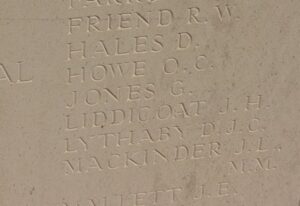
Gomer Jones, Private, STK/722, Royal Fusiliers. Gomer was born on 8 January 1894, the son of Thomas and Mary Jones, of Preswylfa, Gorseinon. His father was headmaster of Gorseinon School. Upon leaving Gowerton School, Gomer worked as an Assistant Draper at Wallis and Co, Holborn Circus, London. He enlisted in London in August 1914 into the 10th (Stockbrokers) Battalion, Royal Fusiliers. The battalion landed in France on 30 July 1915, attached to 111 Brigade, 37th Division. The division landed at Boulogne on 30 July 1915 and concentrated near St Omer. It then took part in the attack on the Gommecourt Salient on 1 July 1916, during the first phase of the Battle of the Somme. From 6 July two of the Division’s infantry Brigades (111 and 112) and the Divisional pioneers were then attached to the 34th Division, which had suffered very heavy losses in the attack on La Boisselle. Gomer was killed in action during this detachment, after being selected to join an officers patrol on 15 July 1916. He was 22-years-old when he was killed that day, and is commemorated on the Royal Fusiliers panels, Pier and Face 8 C, 9 A, and 16 A, of the Thiepval Memorial, France. His brother, Emrys, also fell.
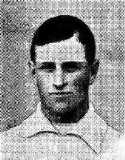
Harold Edward Jones, Private, 55581, Royal Welsh Fusiliers. Harold was the son of David and Elizabeth Jane Jones, of 1, Sterry Road, Gowerton, Swansea. He was a well-known violinist, who had played at the Queen’s Hall, London, while only 12 years of age. Upon leaving Gowerton School he enlisted into the army and was posted to the 2nd Battalion, Royal Welsh Fusiliers, a well-regarded battalion which was home to several of the most famous literary sons of the Great War, including; Robert Graves, Siegfried Sassoon, Bernard Adams, James Churchill Dunn, and Frank Richards. Harold joined the battalion in France late in 1915, probably as a reinforcement following the Battle of Loos, and spent some time attached to the brigade Trench Mortar Battery, as well as being a member of the 33rd Divisional Band. The 2nd RWF had an interesting war, being attached to 19 Brigade, it had been attached to several divisions: the 6th Division until 31 May 1915 when it transferred with the Brigade to the 27th Division; on 19 August 1915 the Brigade transferred to the 2nd Division; on 25 November 1915 the Brigade transferred to the 33rd Division, taking part in the Battle of the Somme in 1916 and in the Third Battle of Ypres in 1917. On 6 February 1918 the 2nd RWF broke away from 19 Brigade and transferred to 115 Brigade, 38th (Welsh) Division. It took part in the great offensive launched by the Division across the Ancre Valley on 21 August and played a big part in driving the Germans back towards the Hindenburg Line. Following the breaking of the Germans last defensive line on 2 October 1918 the Welsh Division advanced towards the Forest of Mormal, and had advanced through it when the Armistice was declared on 11 November 1918. Harold had survived all of this terrible fighting only to fall ill just after the Armistice, and died of pneumonia at 21 Casualty Clearing Station, Caudry on 17 November 1918, aged 22. Harold is buried in grave I. E. 25. In Caudry British Cemetery, France.
Hugh Jones, Sergeant, 317, Welsh Guards. Hugh was born in Burry Port in 1884, the son of David and Emma Jones. The family moved to Gowerton when Hugh was young, and upon leaving Gowerton School, Hugh found work as a Shipping Clerk in Swansea Docks. He married Sarah Hilda Davies in 1905, and the couple set up home at 3, Vivian Road, Sketty. Hugh had already enlisted into the Grenadier Guards, but transferred into the Welsh Guards when it formed by Royal Warrant on 26 February 1915, and embarked for France with the battalion on 17 August 1915, where it joined the 3rd Guards Brigade, Guards Division. The Welsh Guards played an active role throughout its time thereafter, seeing major action during the Battle of Loos on 25 September 1915, remaining in the area during the coming months, where they also fought in the subsequent Action of Hohenzollern Redoubt. In July 1916 the Division moved to the Somme, where they fought at the Battle of Flers-Courcelette, and then at the Battle of Morval, capturing Lesboeufs Village. They remained here for the winter, and in March 1917 took part in the advance caused by the German Retreat to the Hindenburg Line. Later that year they moved north to Ypres, where they fought at the Battle of the Pilckem, and then at the Battle of the Menin Road, Battle of Poelcapelle and the First Battle of Passchendaele. November saw them move south again, where they took part in the Battle of Cambrai. They remained in the area over the final winter of the war, and were stationed near Gouzeaucourt when the German Spring Offensive hit the area on 21 March 1918, at the Battle of St Quentin. The British retreated in the face of this onslaught, fighting at the First Battle of Bapaume, before the Guards Division retreated west and faced the Germans at the First Battle of Arras 1918. After this, the German Offensive petered out on the Somme, and on 8 August the Australian Corps advanced towards the town of Villers Bretonneux and won a mighty battle there against the Germans, thus turning the war. On 21 August the British launched an attack on the Somme, and the Guards Division fought here at the Battle of Albert, and then pushed east, fighting at the Battle of Bapaume. From here on the Allies had the upper hand, and moved towards the Hindenburg Line, where the Guards Division fought at the Battle of Havrincourt and the Battle of the Canal du Nord. Once the Hindenburg Line had been broken, the Allies swept eastwards over territory that had been occupied by the Germans for four long years. The Guards fought at the Battle of Cambrai, and then the Pursuit to the Selle, the Battle of the Selle and the Battle of the Sambre. Hugh became ill towards the end of the war, and died in hospital in Rouen on 30 October 1918, aged 34, just two weeks before the cessation of hostilities. He is buried in grave S. III. I. 16. In St. Sever Cemetery Extension, Rouen, France.
Johnnie Jones. Johnnie cannot presently be identified, but a newspaper article reported that he was from Gorseinon and had served in the Mercantile Marine. He was dead before the end of 1916, but nothing further can be traced about him as he does not appear to be officially commemorated by the CWGC.
Reginald William Bamford Jones, Lance Corporal, 29519, Royal Welsh Fusiliers. Reginald was the son of David and Louisa Elizabeth Jones, of School House, Fforestfach, Swansea. His parents were both teachers at Cockett School. Upon leaving Gowerton School, Reginald began his studies at Cardiff University, but being a patriotic young man, left to enlist into the 21st Battalion, Royal Welsh Fusiliers on 10 December 1915. He spent some time training in North Wales before being posted to France, and embarked from Folkestone on 17 June 1916, to join the 1st Battalion, Royal Welsh Fusiliers. The battalion had been in France since October 1914, attached to 22 Brigade, 7th Division, and by the time Reginald joined up with it was in billets on the Somme, in the Fricourt Sector. Reginald joined the battalion on 9 July, when it was in reserve after having taken part in the opening phase of the Somme offensive. A gifted soldier, he soon gained his promotion to Lance Corporal, and saw his first action during the Battle of Bazentin, and then took part in the Attack on High Wood, playing a successful part in the ‘dawn attack’, and were also the first troops into High Wood. Reginald wrote a detailed letter to his parents at the end of July, chronicling the fighting around Mametz Wood. On the following day his father received a letter from the War Office asking for Reginald’s whereabouts, as there would be dire penalties for him if he did not enlist! By the beginning of August, the 1st RWF had marched back to billets at La Chaussée to rest and receive more reinforcements, following their losses at High Wood. On 12 August the men moved by train to Dernancourt and remained in billets until moving back into the line on 26 August in preparation for an assault on the fortified village of Ginchy, which lay to the east of Delville Wood. Reginald had, by now, been promoted Sergeant, and marched with the battalion to the north of Bernafay Wood, in readiness for the assault on the east of Delville Wood, which had been set for that night. Bombing parties begun making their way forward at 21.45 that night, and the battalion advanced, but became split by the enemy who were holding the corner of Delville Wood, north of Hop Alley trench. Heavy fighting continued over the next two days, and when the 1st RWF was finally relieved on the night of 29 August 1916, Reginald had been killed, most likely during that days fighting. The 23-year-old has no known grave, and is commemorated on pier and face 4A of the Thiepval Memorial, France.

Richard Emrys Jones, Private, 260120, Cheshire Regiment. Richard was the son of Richard Owen Jones and Elizabeth Ann Jones, of Meadowslea, Fforestfach, Swansea. He enlisted at Swansea into the Monmouthshire Regiment, with the army number 228234, but when he was posted to France he was transferred to the 13th Battalion, Cheshire Regiment, which was attached to 74 Brigade, 25th Division. The Division had landed in France on 26 September 1915, and was posted to the Vimy area, where it defended Vimy Ridge against a German attack in May 1916. It then moved to the Warloy area and attacked on 3 July 1916 near Thiepval. The division fought throughout the Battle of the Somme, and then moved to Ploegsteert, where it held the line for the months leading up the Battle of Messines in June 1917. After fighting at Messines, the Division moved north, and fought at Pilckem Ridge. Due to heavy casualties, the Division was withdrawn on 9 September 1917, moving to the Bethune area. On 4 October 1917 it took over the Givenchy Sector, where it helped train Portuguese troops. Richard was wounded during this quieter period of the war, and was evacuated to hospital in Bethune, where he died of his wounds on 8 November 1917. The 21-year-old was buried in grave VI. H. 10. In Bethune Town Cemetery, France.
Thomas J. Jones. Thomas cannot presently be identified. He was not named on the original list of names for the war memorial, which was published in ‘The Gowertonian’ in 1919, so must have died after that date and before the commissioning of the war memorial. He was also not named among any of those from the school who served, so is presently somewhat of a mystery. One possibility is that this was Thomas John Jones, a former gunner with the 1st Welsh Howitzer Brigade, Royal Field Artillery, who died of tuberculosis in Swansea in 1921, but no link to Gowerton School can be traced. His details are as follows:
Thomas John Jones, Gunner, 725452, Royal Field Artillery. Thomas was the son of William and Catherine Jones, of 111 Courtenay Street, Manselton, Swansea. He enlisted at Swansea into the 1st Welsh Howitzer Brigade, Royal Field Artillery on 11 January 1915 and after training was posted firstly to the Glamorgan Battery, Royal Field Artillery and on 29 August 1917 was posted overseas to Egypt, joining B Battery, 37th Brigade, Royal Field Artillery. While based in Cambridgeshire he met his future wife, Eleanor Ann Pearson, and the couple married at St. Neots on 26 May 1917, shortly before his posting. Eleanor moved to live with his parents while Thomas was oversea, and he saw much service in the Palestinian campaign over the coming months. On 27 September 1918 he returned to Britain after falling ill, and was diagnosed as suffering from tuberculosis. He died in the summer of 1921, aged 29. Nothing further is known of Thomas, as he is not commemorated by the CWGC.
William Myrddin Jones, Sergeant, 1381, Welsh Regiment. William was born at Llandeilo-Talybont, the son of James and Elizabeth Jones. After the death of his father, who was a Colour Sergeant in the 3rd Volunteer Battalion, Welsh Regiment, the family moved to Enfield, Park Road, Gorseinon and William started working at Lewis’ Works. William served with the 1/6th Battalion, Welsh Regiment, which was the Glamorgan Territorial battalion of the Welsh Regiment, and moved to France on 29 October 1914, moving to work on Lines of Communication near Calais. On 5 July 1915 the battalion moved to 84 Brigade, 28th Division, then on 23 October 1915 transferred to 3 Brigade, 1st Division, becoming the Divisional Pioneers. During the first week of July 1916 the 1st Division began to move away from the Calonne Sector and started the long march south towards the Somme. By 12 July the 6th Welsh had moved forwards to Contalmaison and begun work wiring and clearing the battlefield. Work continued over the coming days, under occasional shellfire, constructing trenches in preparation for the forthcoming Australian assault on Pozieres. After suffering terrible conditions, on 26 July the 6th Welsh moved back into billets at Baizieux in reserve and continued in their work, building dug-outs and repairing roads. On 15 August the men marched back to the front line, to bivouacs in Fricourt Wood, and started work on dug-outs while under heavy fire, suffering a number of casualties in the coming days. It was under these terrible conditions, with intermittent shelling and attacks by aircraft, that the 6th Welsh were working under on 29 August 1916, when William was killed after being hit by a whizzbang. He was 23 years old, and is buried in grave I. E. 31. in Flatiron Copse Cemetery, Mametz, France. Just days earlier his brother, Sergeant Thomas Benjamin Jones, had been wounded and evacuated to hospital.

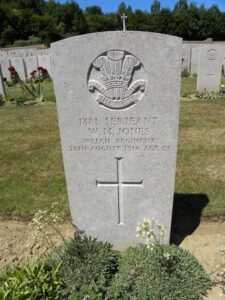
David Lewis, Private, 763792, London Regiment. David was the son of John and Rachel Lewis, of Duffryn House, Penllergaer. After leaving Gowerton School he became a clerk, and enlisted at Swansea into the 28th Battalion, London Regiment (Artists’ Rifles) on 11 December 1916 and embarked at Southampton on 26 May 1917 for France. He joined up with the battalion near Arras a week later, where it was holding the line near Oppy and Gavrelle and was attached to 190 Brigade, 63rd (Royal Naval) Division. David was wounded in the neck at Arras on 28 July 1917 and was brought slowly back via a network of dressing stations and casualty clearing stations to the Australian General Hospital at Rouen over the coming days where he received expert medical treatment. On 24 August he was carried aboard Hospital Ship SS St. George in order to be taken to a specialist hospital in England, but died of his wounds aboard the ship on 25 August 1917, aged 21. His body was taken home to be buried with full military honours in grave II. 6. in St. David’s Churchyard Extension, Penllergaer.
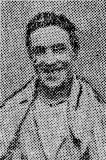
William Joseph Lewis, Corporal, 113043, Royal Engineers. William was the son of John and Mary Lewis, of Gwernffrwd, Penclawdd. After leaving Gowerton School he was educated at the University of Wales, Cardiff before gaining a post with the National Health Insurance at Cardiff in 1913. He enlisted into the Public Schools Battalion of the Royal Fusiliers in September 1914, but due to his knowledge in chemicals was transferred to the Royal Engineers in August 1914, joining the Special Brigade, which was the gas warfare arm of the corps. He was drafted to France on 23 August 1915, joining ‘M’ Special Company, Royal Engineers. By the summer of 1916 William was on the Somme with his unit, based in the northern sector of the battlefield. On 14 July 1916 his company was at work when it came under a heavy German artillery bombardment. William was reported to have bravely stuck to his post during the bombardment, which ultimately killed him. The 27-year-old is buried in Bienvillers Military Cemetery, France, in grave XV. A. 7.
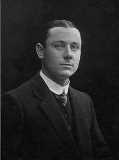
Thomas Mitchell, Private, 23237, Worcestershire Regiment. Thomas was the son of Mungo and Jane Mitchell, of Albion House, Waunarlwydd. He served an apprenticeship as a joiner after leaving Gowerton School, and enlisted into the 11th Hussars at the outbreak of war. He was subsequently posted to France on 14 July 1915 and transferred to the 3rd Battalion, Worcestershire Regiment, which was attached to 7 Brigade, 3rd Division and was in positions east of Ypres, at Hooge. The battalion been involved in much fighting at Ypres, and Thomas joined the depleted battalion in bivouacs at Busseboom. After a brief respite, the battalion relieved the 1st Royal West Kents in the front line near St. Eloi on 22 July, beginning a torrid spell which saw the explosion of several underground mines on their front, and also on the German front lines. Thomas was among a number of men killed or wounded when a German mine burst beneath the right of their line on 26 July 1915. He was just 19 years old and is buried in grave VIII. B. 10. in Voormezeele Enclosure No. 3, Belgium.
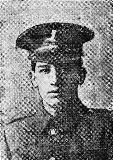
David Arthur Mort, Pioneer, 155373, Royal Engineers. David was born in 1896, the son of David and Kate Mort, of Llangyfelach, Morriston. After leaving Gowerton School he attended a prize giving evening at Gowerton School in June 1914, following his Matriculation to Aberystwyth University. He began his studies at Aberystwyth University and had graduated with his inter BA in Geology and had also played football for Mynyddbach F.C. prior to enlisting at Aberystwyth into the Royal Welsh Fusiliers. David was then transferred to the 1st Battalion, Special Brigade, Royal Engineers, a gas warfare unit, and landed in France early in 1916. David was badly wounded on the Somme in 1916, and was evacuated to the 1st Australian General Hospital at Rouen, where he died on 1 July 1916, aged 19. David was buried in grave A. 21. 46. in St. Sever Cemetery, Rouen, France. The inscription on his headstone reads: ‘CANYS BYW I MI YW CRIST A MARW SYDD ELW’. Two of his brothers served with the Royal Navy and one in the army, and one survived the sinking of HMS Natal, when she suffered an internal explosion and blew up while at anchor near Cromarty on 30 December 1915 with the loss of at least 390 crewmen and civilians

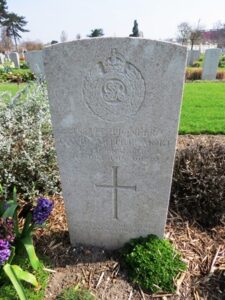
John Emlyn Rees, Lance Sergeant, 2450, Welsh Regiment. John was the son of Daniel and Naomi Rees, of Ael-Y-Bryn, Belgrave Road, Loughor. He had been the Secretary of Loughor Rugby Club prior to the war, and enlisted at Gorseinon into the 1/6th Battalion, Welsh Regiment. The battalion was one of the first territorial units to move to France in August 1914. Initially, in late 1914 and early 1915, they were on lines of communication and in July 1915 were based in the Locre and Kemmel area, facing the Germans who were on the high ground at Spanbroekmolen. The battalion was in the trenches, but also doing work repairing trenches etc. On 5 July 1915 the battalion was attached to 84 Brigade, 28th Division, and took part in the Battle of Loos. On 23 October 1915 the battalion was transferred to 3 Brigade, 1st Division, which was in the Loos sector. John was mortally wounded and died at Loos on 21 February 1916, aged 24, within days of returning to the front following a spell of leave. He is buried in grave I. A. 41. in Maroc British Cemetery, Grenay, France. The base of his headstone is inscribed: ‘BLESSED ARE THE DEAD THAT DIE IN THE LORD’.
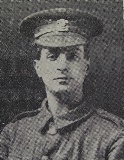
Edward John Thomas, Private, GS/21327, Royal Fusiliers. Edward was the son of Thomas and Anne Thomas, of Church Street, Gowerton. He had migrated to New Zealand prior to the war, setting up his own business, which became very successful, and was home visiting his family when war erupted. Edward enlisted at Swansea into the army and was posted to the 9th Battalion, Royal Fusiliers, which was attached to 36 Brigade, 12th Division, and had originally landed in France in May 1915. Edward joined the battalion early in 1916, prior to its move to the Somme in March 1916. The division took part in the assault on the strongly defended German held village of Ovillers on 2 July 1916, and suffered heavily during the ensuing battle. Ovillers proved to be strongly held, so a further assault on the village was carried out by 36 Brigade on 7 July 1916. The 9th Royal Fusiliers, attacking alongside their sister battalion, the 8th Royal Fusiliers, suffered terrible casualties during the day, capturing the bulk of the village, but suffering terribly. Only 300 men from the two battalions marched back to safety the following day. Edward was among the many dead. He was posted as missing on 7 July 1916, but no trace of him was ever found, so the 30-year-old is commemorated on the Royal Fusiliers section, Pier and Face 8C, 9A and 16A, of the Thiepval Memorial, France.
William Rees Thomas, Signaller, Wales/Z/2495, Royal Naval Volunteer Reserve. William was born on 14 September 1891, the son of David and Rachel Thomas, of Treboeth, Landore, Swansea. After leaving Gowerton School he became a Solicitor’s Clerk for Baldwin’s Ltd, of Wind Street, Swansea. He enlisted at Swansea on 16 November 1915 and after training at HMS Vivid was posted aboard the battlecruiser HMS Invincible. She was the first battlecruiser to ever be built, and had to be converted to hydraulically powered gun turrets prior to the war, in order to be competitive with other similar ships. She took part in the Battle of Heligoland Bight early in the war and also in the Battle of the Falkland Islands, where, alongside her sister ship Inflexible, they sank the armoured cruisers Scharnhorst and Gneisenau almost without loss to themselves, despite numerous hits by the German ships. Invincible then became the flagship of the 3rd Battlecruiser Squadron, and alongside the squadron took part in the Battle of Jutland on 31 May 1916. The squadron became detached from Admiral Beatty’s Battlecruiser Fleet a few days before the battle for gunnery practice with the Grand Fleet and acted as its heavy scouting force during the battle. Invincible was heavily engaged with several German battleships during the battle, when she was hit by a salvo of 12” shells which penetrated her Q Turret and set off a cataclysmic explosion in her magazines, which tore the ship apart and sent it to the bottom in less than two minutes. William was among over 1,000 men killed in the sinking of Invincible that day. He was 25 years old and is commemorated on panel 19 of the Plymouth Naval Memorial, Devon.
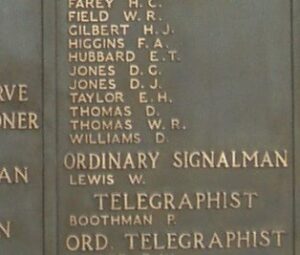
David Walters, Private, 26669, Gloucestershire Regiment. David was the son of William and Mary Ann Walters, of Ad y Bryn Cottages, Penllergaer. He enlisted in Bristol into the Gloucestershire Regiment, and at some time in 1916 was posted to France to join the 1st Battalion, Gloucestershire Regiment, which was attached to 3 Brigade, 1st Division. The division had been moved to the Somme sector in June 1916 to take part in the Somme offensive, which was launched on 1 July 1916. On 10 July the 1st Gloucester’s, along with 3 Brigade, moved forwards from reserve to Dernancourt, some miles behind the front. On the following days the brigade remained in billets at Albert, before moving into the line at Contalmaison on 14 July. Two days later the 1st Gloucester’s attacked, alongside the 2nd Welsh, strong German positions near Pozieres, known as the OG Lines, while to their left the Australians assaulted Pozieres village. Heavy fighting continued over the coming days and the Gloucester’s were relieved on 18 July, moving back to billets two days later after bivouacking at Bécourt Wood, before moving back into the line on the 25th, relieving the 2nd Welsh. After two more days in the line, in terrible conditions, the Gloucester’s were again relieved and marched back to Millencourt. After two weeks in reserve the brigade began to march back to the new front line on 15 August, and on 20 August 1916 relieved the 2nd KRRC in the front line near High Wood and over the coming days suffered terrible shellfire as well as being forced to beat off several German counter-attacks. On 26 August the Gloucester’s line was obliterated by shellfire, forcing the desperate men to shelter in shell-holes. A fresh offensive by the 1st Division was planned for the night of 27-28 August, but instead of being part of the attack, the battered Gloucester’s were relieved by the 10th Scottish Rifles during the day of the 27th, to march back to Bécourt Wood. The Germans must have spotted the movement of troops during the relief and opened up a murderous artillery barrage on them, killing and wounding a number of men of the Gloucester’s before they managed to get back to the safety of the wood. David had been killed during this relief on 27 August 1916 and was buried on the battlefield by his comrades. During the post war battlefield clearances his grave was exhumed and he was re-interred in grave II. F. 4. in Lonsdale Cemetery, Authille, France.
Trevor Lewis Williams, Lieutenant, Royal Air Force. Trevor was the son of Thomas and Margaret Williams, of Ynys House, Pontarddulais. Trevor had volunteered to serve with the Royal Flying Corps, and had been commissioned on 5 July 1917 after gaining his flying certificate with No 6 O.C.B. at Oxford. He was posted initially to 28 Squadron, then to 79 Squadron before being re-posted to 72 Squadron, Royal Flying Corps, which had formed at Netheravon on 2 July 1917 from a nucleus provided by the Central Flying School. The squadron embarked for the Middle East on Christmas Day 1917, re-grouping in Basra on 2 March 1918. That month the Royal Air Force was born, formed out of the merging of the Royal Flying Corps and the Royal Naval Air Service. 72 Squadron operated in Mesopotamia as self-contained Flights allotted to individual Army Corps using a variety of aircraft, including: Bristol M1c Bullets; Spad VIIs; Martinsyde G100s; and SE5s to carry out the various tasks required. Trevor had endured some harsh conditions here, being hospitalised in June 1918 after falling ill, as did many troops in the harsh conditions of the desert, but soon returned to service. On 6 October 1918 he took part in a routine flight and came across a large number of enemy troops, which the flight attacked and scattered. He wrote home to his parents about his experience during this operation, where his aircraft was forced down. After landing safely, Trevor set his machine alight before beginning the long walk to safety. He was taken in to the house of an elderly couple during the night, where he was robbed of all his belongings at knifepoint the following morning, being left with only his shirt, shorts and socks. Borrowing an Arab robe, he continued his walk barefoot that day and after a five-day ordeal which saw him forced to evade a number of Turkish patrols, he reached the safety of the British lines. The letter reached his parents shortly after his death, most likely of sickness, on 1 January 1919, aged 21. Trevor is buried in grave X. C. 2. in Baghdad (North Gate) War Cemetery, Iraq. The inscription at the base of his headstone, which has sadly since been destroyed following the vandalism of the cemetery, read: ‘ASLEEP IN JESUS’.
THEY GROW NOT OLD
Gallantry Awards to former Gowerton Pupils, WW1, 1914-1918
Edgar Davies, MM, Lance Corporal , 49311, Royal Engineers. Edgar was from Pontarddulais. His award of the Military Medal was for gallantry during the Third Battle of Ypres and was published in the London Gazette of 1 February 1918. In November 1917 he returned home to Pontarddulais to a hero’s welcome and was presented with a number of gifts.
Arthur Trevor Harries, MiD, Captain, Royal Welsh Fusiliers. Arthur was the son of Alderman Rees Harries, of The Bolgoed, Pontarddulais. After graduating from Gowerton School he gained his BA and Ll.B with Honours at Aberystwyth prior to being commissioned into the Royal Welsh Fusiliers. He was promoted Captain and joined the Staff of the 98th Infantry Brigade after being mentioned in despatches. His brother, David George Harries, was killed in action in 1915. Sir Arthur Trevor Hopkins later became Chief Justice of the High Court in Patna, and died in India on 1 July 1959.
David Arthur Hopkins, MiD, Sergeant, 17063, Welsh Regiment. David was the son of David and Annie Hopkins, of Cockett. He embarked for France as a Sergeant with the 14th Battalion, Welsh Regiment, which was attached to 114 Brigade, 38th (Welsh) Division on 2 December 1915, and was at some time transferred to the Army Service Corps, after being mentioned in despatches for gallantry on the field.
Gwynfryn Jenkins, MC, Lieutenant, Machine Gun Corps. Gwynfryn was the son of John and Mary Jenkins, of Cwyn-yr-Awel, Gowerton. His award of the Military Cross was published in the London Gazette of 8 January 1918, and read: ‘For conspicuous gallantry and devotion to duty. He led his four guns to their objective with the infantry assault, and in spite of heavy casualties, placed them in good defensive positions and made complete arrangements for the-supply of ammunition, which had run short. He afterwards took charge of two more machine guns when their officer had been killed, and kept all six guns in action for three days in spite of continuous and severe shell fire, which reduced the teams to a minimum. But for his cheerfulness, gallantry and untiring efforts in going from gun to gun and encouraging the men, they could never have stood the strain.’ His brother Owen was killed during the war. Gwynfryn died in 1955.
Christopher Gwyn Morgan, MC, Lieutenant, 127802, Royal Army Service Corps. Christopher was the son of Christopher and Margaret Morgan, of Penscallen, Loughor. He was commissioned into the 18th Battalion, West Yorkshire Regiment on 16 July 1915, and was awarded the Military Cross for his gallantry during with the battalion the 100 Days Offensive. The citation was published in the London Gazette of 15 October 1918 and read: ‘After the objectives of an important attack had been successfully reached, Captain Morgan promptly reorganised his company and consolidated the advanced posts with great initiative. When the posts on his flank were forced to withdraw for a short distance, owing, to the heavy and persistent enemy shelling, he maintained his positions until the situation could be restored. He set a fine example to his company by his gallant and cheerful bearing throughout the whole operation.’ On 8 May 1940 he was gazetted into the Royal Army Service Corps. He contracted pneumonia while on manoeuvres at Salisbury Plain, and died in hospital in Dorset on 24 January 1941, aged 41. Christopher is buried in Shaftesbury Borough Cemetery, Dorset. He is commemorated on the World War Two Memorial in Gowerton School.
Benjamin Percy Rees, MM, Bombardier, 625337, Honourable Artillery Company. Percy was the son of William and Margaret Rees, of Milford House, Borough Road, Loughor. He was working at Gorseinon School when he enlisted in January 1916 and served with the artillery section of the 1st Battalion, Honourable Artillery Company. He was awarded the Military Medal in 1917 for conspicuous conduct, in leading and directing a party to extinguish a fire of artillery screens and ammunition dumps which had been caused by a direct hit from artillery. The award was published in the London Gazette of 19 November 1917.
World War Two, 1939-1945
Graham Aeron Alcock, Sergeant, 978333, Royal Air Force Volunteer Reserve. Graham was the son of William Alcock and Margaret Alcock (nee Lloyd), of Garden Village, Gorseinon. He enlisted into the Royal Air Force Volunteer Reserve and trained as a Wireless Operator/ Air Gunner before being posted to 10 Squadron, Royal Air Force, which was based at RAF Leeming, equipped with the Armstrong Whitworth Whitley. Graham was killed when his Whitley bomber, with one engine shot away, crashed in flames near Thetford, Norfolk while returning from a raid over Germany on 1 July 1941. The body of the 20-year-old was brought home for burial in Kingsbridge Cemetery, Glamorgan, in section A. grave 258.
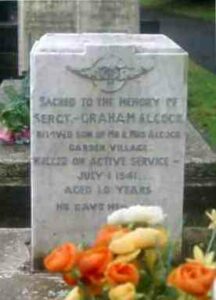
James Black, Gunner, 3960619, Royal Artillery. James was born at Gorseinon in 1918, the son of James Black and May Black (nee Evans). The family later resided at Pontnewynydd, Monmouthshire. James enlisted into the 25th Field Regiment, Royal Artillery. The regiment embarked for North Africa where it became attached to the 4th Indian Division in the summer of 1941. James was killed near Tobruk, during Rommel’s great attack in North Africa, on 20 June 1942. He was 24 years old, and is commemorated on column 34 of the Alamein Memorial, Egypt.
William Clayton, Sergeant, 1254858, Royal Air Force Volunteer Reserve. William was the son of Richard and Margaret Clayton, of 4, New Road, Grovesend, Glamorgan. Upon leaving Gowerton School he gained his BA at the University of Wales, Cardiff. He joined the Royal Air Force Volunteer Reserve and trained as a pilot before being posted to 12 Squadron, Royal Air Force, which flew the Vickers Wellington from RAF Binbrook in Lincolnshire. On the night of 8 June 1942, William took off from Binbrook aboard Wellington Z8652, bound for a raid on Essen. Nothing further is known about what happened to William and his crew, but they failed to return the following morning, 9 June 1942, and were presumed to have been brought down by anti-aircraft fire over the Ruhr. The crew of the aircraft were recovered by the German authorities after the crash and buried together. William was 31 years old when he was lost that day and is buried in Reichswald Forest War Cemetery, Germany, in grave 9. B. 7.
Reginald Owen Clee, Warrant Officer, 1068617, Royal Air Force Volunteer Reserve. Reginald was the son of Lewis John Clee and Elsie Margaret Clee, of Pontlliw, and had studied for his B.Sc. at the University of Wales prior to the war. He then served with 256 Squadron, RAF. The Squadron reformed in a night fighter role on 23 November 1940 at Catterick, equipped with Defiants. It then moved to Pembrey, from where it began operations in February 1941. From March 1941 it was based in the North-West to defend the Merseyside area until April 1943, when it moved to Ford. In May 1942, the Defiants were replaced by Beaufighters and a year later these were superseded by Mosquito XIIs. July 1943, saw the squadron supply a detachment to Luqa in Malta to provide night cover for the invasion of Sicily. Once the invasion of Italy was complete, the rest of the squadron arrived in Malta on October, remaining there until April 1944. Its next move was to Algeria, absorbing the Gibraltar Defence Flight equipped with Spitfires in May. Reginald was reported as missing on 27 July 1944, after his plane touched the water when descending to attack an enemy plane off Corsica. He was 23 years old, and is commemorated on panel 13, column 2 of the Malta Memorial, Malta. Reginald is commemorated by a stained-glass window in Pontlliw Primary School.
Edward John Clement, DFC, Flight Lieutenant, 149152, Royal Air Force Volunteer Reserve. Edward was the son of Francis George Clement and Winifred Elizabeth Clement (nee Bryan), of Gorseinon. His mother was first cousin to my grandfather. Edward was commissioned into the Royal Air Force Volunteer Reserve on 26 June 1943 and after training as a navigator was posted to 7 Squadron, Royal Air Force, which was an elite pathfinder unit equipped with the Avro Lancaster, based at RAF Finningley. Edward was soon to be awarded the Distinguished Flying Cross for his work with the squadron, the award of which was published in the London Gazette of 19 October 1943. On the night of 17 November 1943 Edward took off from Finningley aboard Lancaster JA970, which was part of a large force despatched to bomb Mannheim. The Lancaster came down in Germany on the following morning, 18 November 1943, killing all her crew. Edward, who was 22 years old, is buried alongside his fellow crew-members in Durnbach War Cemetery, Germany, in collective grave 2. F. 22-26.
Brinley Desmond Davies, Lieutenant, 284888, South Wales Borderers. Brinley was the son of Idris Davies and Florence Davies (nee Evans), of Three Crosses, Glamorgan and the husband of Amy Davies. He was commissioned into the South Wales Borderers, but had been attached to the 7th Battalion, Royal Welsh Fusiliers, which was attached to the 53rd (Welsh) Division. The division landed in Normandy in the middle of June 1944 and took part in the heavy fighting which led to the break-out from the Normandy beach-head. Following the capture of Caen and the break-out from Normandy in August 1944, the British drove northwards through France and Belgium into Holland, taking part in Operation Market Garden at the end of September. By the first week of February 1945 the 53rd (Welsh) Division had crossed the Rhine and was advancing towards the German frontier into the Reichswald Forest where the division took part in heavy fighting. Brinley was badly wounded in the forest and died of his wounds on 11 February 1945. The 26-year-old is buried in grave 10. C. 2. in Jonkerbos War Cemetery, Netherlands.
David Garfield Davies, Staff Sergeant, 7400698, Army Air Corps. David was the son of Daniel and Ruth Davies, of Penclawdd. He served with the No. 4 Flight, B Squadron of the Glider Pilot Regiment. David’s squadron was part of the massive force which had been rapidly assembled in order to take part in Montgomery’s plan to cross the Rhine and end the war before Christmas, which was code-named Operation Market Garden. Garden was the ground operation which required XXX Corps to advance up a single road towards Arnhem to relieve the airborne element, codenamed Market, whose task was to capture the Rhine crossing at Arnhem. American paratroopers of the 101st and 82nd Airborne were allotted bridges along the route XXX Corps were to take. The airborne element was launched on 17 September 1944, when the first lift took off and dropped their troops on the LZ, some distance outside Arnhem. The paratroopers soon found that the distance from the LZ to the bridge was too much to utilise the element of surprise, but a small force under Major John Frost reached the bridge, but were unable to capture both ends. Meanwhile David, who had been a crewmember of a Horsa Glider which had brought troops over, had taken up his secondary role, as a soldier, and was part of a group of men caught up in heavy fighting against well trained, armoured German troops. David was part of a group of men who were last seen alive pinned down in a slit trench and being assaulted by enemy tanks on 25 September 1944. The 25-year-old was later declared to have been killed on that day. He has no known grave, although at least two graves to Unknown Staff-Sergeants of the Glider Pilot Regiment are known to exist at Arnhem, and as a result he is commemorated on panel 8 of the Groesbeek Memorial, Netherlands.
Graham Davies, Warrant Officer, 964498, Royal Air Force Volunteer Reserve. Graham was the son of William Idris and Mary Davies, of Pontarddulais. He served as a Wireless Operator/ Air Gunner with 524 Squadron, RAF, which was a Coastal Command Squadron, equipped with the Vickers Wellington. Graham was returning from an anti E-Boat mission near Caen, Normandy, when his Wellington XIII, Serial MF616, crashed while attempting to land at Davidstow Moor in mist on 8 June 1944, killing all the crew. Graham was 23 years old, and is buried in grave 1438 in Rhydgoch Cemetery.
Gwilym Powell Davies, Able Seaman, D/JX175328, Royal Navy. Gwilym was born at Penclawdd on 26 March 1918, the son of James Davies and Mary Jane Davies (nee Powell). He was the husband of Sarah Anne Davies, of Crofty. Gwilym enlisted into the Royal Navy and was posted to the shore establishment HMS Drake. He became ill after taking part in a convoy run to Murmansk and died of cardiac failure and acute asthma at Wembury, Plymouth, on 28 July 1942, aged 24. His body was brought home for burial in Crofty (Hermon) Baptist Chapel Burial Ground, to the north-west of the Chapel.
John William Thomas Davies, Sergeant, 977311, Royal Air Force Volunteer Reserve. John was the son of Daniel and Catherine Davies, of Gowerton. He trained as a Wireless Operator/ Air Gunner before being posted 405 (R.C.A.F.) Squadron, Royal Air Force, which operated the Vickers Wellington from RAF Driffield in Yorkshire. The squadron moved to RAF Pocklington in June 1941, and it was from here that John took off aboard Wellington W5488 on his final mission to bomb Duisberg. The aircraft crashed in Germany on 29 August 1941. John was 20 years old and is buried in grave 1. A. 18 in Rheinberg War Cemetery, Germany.
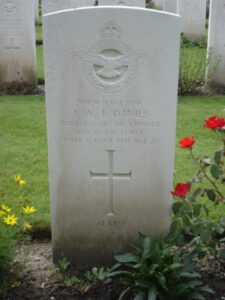
Lewis Randolph Davies, Private, 14670492, Welch Regiment. Lewis was the son of Trevor and Mary Davies, of Pontlliw, and served with the 1/5th Battalion, Welsh Regiment. Lewis landed in Normandy with the battalion in June 1944, and fought during the break out from Normandy, and the drive through France and Belgium into Holland, taking part in Operation Market Garden. Lewis was killed on 1 October 1944 while fighting near St. Odenrode, as the 53rd Division was advancing towards s’Hertogenbosch. He was 19 years old, and is buried in grave 1. E. 2. in Uden War Cemetery, Netherlands.
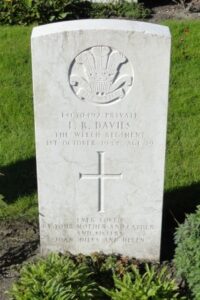
Philip Edward Davies, Flight Sergeant, 1317450, Royal Air Force Volunteer Reserve. Philip was the son of William Thomas Davies and Emily Maria Davies, of Pontarddulais. He served with 227 Squadron, Royal Air Force, which was equipped with the North American Mitchell, and was based in the Mediterranean. On 30 March 1944, Philip took off from Benghazi to re-join his flight on convoy duty, but did not contact them. He was presumed lost in the Aegean Sea by enemy action that day. Philip was 23 years old, and is commemorated on column 279 of the Alamein Memorial, Egypt.
John Henry Edmunds, Private, 14442193, Worcestershire Regiment. John was born in Three Crosses in 1924. He possibly married Enid Elliott at Swansea in 1944. John served with the 7th Battalion, Worcestershire Regiment, which had seen heavy fighting in Burma, especially during the Battle of Kohima which took place between 4 April and 22 June 1944. During the morning of 25 February 1945, the battalion had formed up in readiness to assault the Japanese held Ava Bridge. The men crossed the Irrawaddy by boats, but were spotted by the Japanese who opened up a murderous rain of machine-gun fire onto the boats. The men were forced to turn about and withdraw to their side of the river, but had incurred only light casualties. John was among those to lose his life during the crossing, dying on 26 February 1945. The 20-year-old is buried in grave 25. D. 21. in Taukkyan War Cemetery, Myanmar.
David John Edwards, Guardsman, 2737056, Welsh Guards. David was the son of Arthur Haydn Edwards and Elizabeth Jane Edwards (nee Davies), of Loughor. He served with the 2nd Battalion, Welsh Guards. The 2nd Battalion was formed in 1939 and fought during the German siege of Boulogne in 1940, before the survivors were evacuated to England. The battalion then moved to Codford for training into an armoured unit, which would see the battalion fight in Normandy as part of the Royal Armoured Corps. David appears to have been killed in an air raid on 29 June 1942, aged 27. He is buried in section I, Un-consecrated, Row 1, Grave 999, in Watford Cemetery, Hertfordshire.
David Evans, DFC, Flight Lieutenant, 47511, Royal Air Force Volunteer Reserve. David was the son of David and Elizabeth Ann Evans, of Reynoldston, Glamorgan. He was commissioned into the Royal Air Force Volunteer Reserve early in the war, becoming a pilot in RAF Coastal Command. He was awarded the Distinguished Flying Cross for sinking submarines, the award of which was published in the London Gazette of 7 July 1944. David became a Flying Instructor at some time, and was posted to 1674 Heavy Conversion Unit, which had formed at Aldergrove in October 1943 before moving to Longtown in October 1943, for the purpose of training crews in flying heavy bombers. On 23 October 1944 David was training a crew aboard Handley Page Halifax JB963, on a training flight over Northern Ireland when an engine caught fire and whilst making an emergency approach to land at Aldergrove, crashed near Dundesert Bridge, Co. Antrim. David and three other men were killed in the crash. David was 27 years old and is buried in section 25, grave 6 of Killead (St. Catherine) Church of Ireland Churchyard, Northern Ireland.
Iorwerth Evans, Signalman, 2348579, Royal Corps of Signals. Iorwerth was the son of William and Esther Ann Evans, of Gorseinon. He was a renowned athlete, having gained colours for swimming and gymnastics at national level, and had studied for his BA at the University of Wales. Iorwerth joined the Royal Corps of Signals early in the war and was posted to North Africa, joining the 4th Armoured Brigade Group Signal Section, part of the famous Desert Rats. The brigade fought with the 7th Armoured Division and initially took part in a series of border raids along the frontier and the counter attack at Sidi Barrani. In January 1941, it took part in the successful capture of Tobruk and Bardia and played a role in the surrender of over 25,000 Italians. In May 1941, the Brigade took part in Operation Brevity and later in Operation Battleaxe, in an attempt to lift the siege of Tobruk, and then took part in Operation Crusader and was almost wiped out later that year. During May 1942 is saw heavy fighting during the withdrawal to El Alamein, and was refitted before taking part in the Second Battle of EL Alamein in October 1942. Iorwerth was wounded at Miteirya Ridge during the drive towards Tripoli, and died the following day, on 26 October 1942. The 25-year-old is buried in grave V. D. 3. in El Alamein War Cemetery, Egypt.
John Davies Cross Evans, Sergeant (Pilot), 742933, Royal Air Force Volunteer Reserve. John was the son of David Daniel and Catherine Evans, of Pontarddulais, and served with 9 Squadron, RAF. The Squadron was first equipped with the Vickers Wellington and was based at RAF Honington. On 4 September 1940 the Squadron gained the distinction of making the RAF’s second bombing raid of the war, when together with 149 Squadron it bombed German warships at Brunsbüttel. On 7 October 1940 John was on duty on the flare path at Honington when a damaged Wellington of 149 Squadron crashed whilst attempting a crash landing after returning from a raid on France. John was among three airmen of 9 Squadron killed on the ground. He was 26 years old, and is buried at Pontardawe (All Saints) Cemetery, to the north-east of the Church.
Oscar Griffiths, Flying Officer, 175662, Royal Air Force Volunteer Reserve. Oscar was the son of Lewis Randell Griffiths and Gwladys Ann Griffiths (nee Williams), of Caemansel, Glamorgan. He was commissioned into the Royal Air Force Volunteer Reserve after becoming a pilot and was posted to 100 Squadron, Royal Air Force, which was equipped with the Avro Lancaster, based at RAF Grimsby. On the night of 23 December 1944 aboard Lancaster ND388, as part of a large force despatched to bomb the railway station of Nippes, near Cologne. On the morning of 24 December 1944 Oscar’s Lancaster was shot down and crashed near the target area, killing all her crew. The bodies of the crew were pulled from the wreckage by German soldiers and buried locally, but after the war were re-interred in Rheinberg War Cemetery, Germany. 23-year-old Oscar now lies there, in grave 2. J. 12. alongside his fellow crew-members, one of whom, James Islwyn Morgan, was also from Swansea.
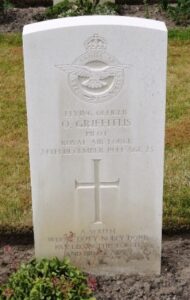
Peter Griffiths, Civilian, Home Guard. Peter was the son of David Griffiths and Kate Griffiths (nee James), of The Ladies Realm, Gorseinon, Swansea. He gained his BSc after leaving Gowerton School, and lived at 32, Tanygroes Street, Port Talbot, working in metallurgical research. He served with the Home Guard during the war and was posted to Surrey with his research work. Peter was killed whilst visiting a friend at Send Barnes Lane, Send, near Woking, Surrey when a V1 missile struck on 12 August 1944. The body of the 21-year-old was brought home for burial in Brynteg Cemetery, Gorseinon.
Gwilym Penry Guy, Pilot officer (Pilot), 172461, Royal Air Force Volunteer Reserve. Gwilym was the son of Enos and Elizabeth Guy (nee Francis), of Penclawdd. He served as a Pilot with 57 Squadron, Royal Air Force, which was a heavy bomber squadron equipped with the Avro Lancaster, and was based at RAF East Kirkby. On the night of 21/22 June 1944, Gwilym took off from East Kirkby flying Lancaster III, Serial LM580, as part of a large force of aircraft sent to bomb a petrol refinery at Wesseling, Germany. In the early hours of 22 June 1944 Gwilym’s aircraft was flying over Belgium when it was hit by flak and began to lose height. He remained at the controls of the stricken Lancaster while his crew bailed out, but was killed when his aircraft plummeted into the ground near As-en-Campine, some 5 miles from Genk, in Belgium. Gwilym was 22-years-old when he was killed that day, and is buried in grave 6 in As Communal Cemetery, Belgium.
Charles Mansel Gwynne, Aircraftman 2nd Class, 983903, Royal Air Force Volunteer Reserve. Charles was the son of Albert and Maud Gwynn of Pontlliw, and the husband of Sarah Phyllis Gwynn, of Uplands, Swansea. He enlisted into the Royal Air Force Volunteer Reserve and trained as a flight mechanic. He was posted to an Advanced Training Squadron at RAF Shawbury, in Shropshire. On 23 September 1940 Charles took to the air from Shawbury as a passenger in an Airspeed Oxford, as part of a flight of three aircraft, and at 11.40 was flying over the village of Hadnall when an Oxford from another unit plunged into the flight, hitting Charles’ aircraft which plummeted to earth, killing Charles and his pilot, Sergeant Alexander Glass Dunbar. Dunbar was buried at his home of Cardross, while Charles, who was 25 years old, was brought home to be buried in grave 5 in Pontlliw (Carmel) Baptist Chapelyard.
Norman Hall, Flight Sergeant, 978968, Royal Air Force Volunteer Reserve. Norman was the son of Charles and Mary Ellen Hall, of Grovesend, Swansea. Norman enlisted into the Royal Air Force Volunteer Reserve and was dent to America to train at the Kaufman County Airport in Terrell, Texas. When he returned to England he was posted to 514 Squadron, Royal Air Force, which was equipped with the Avro Lancaster, based at RAF Foulsham in Norfolk. On the night of 19 February 1944 Norman took off from Foulsham aboard Lancaster DS736, as part of a large force sent to bomb Leipzig. The aircraft was one of a batch which had been built by Armstrong Whitworth Aircraft in 1941 and built as Lancaster BII with Hercules XVI Radial engines instead of the Rolls Royce Merlin, due to worries about the supply of the latter engine. The Lancaster went missing, presumed shot down and crashed, in the morning of 20 February 1944. Norman, who was 24 years old, has no known grave, and is commemorated on panel 218 of the Runnymede Memorial, Surrey.
Emlyn Harries, Serjeant, T/91304, Royal Army Service Corps. Emlyn was the son of Thomas W. and A. Harries, of Pontarddulais. He served in the Far East with 2, Combined Army Depot, Royal Army Service Corps, and was captured when the Singapore Garrison surrendered to the Japanese on 15 February 1942. Emlyn died of malnutrition aboard a Japanese ‘Hell Ship’, as a POW, sometime between 1 and 14 August 1944. He was 29 years old, and was buried at sea in Manila Bay. He is commemorated on column 97 of the Singapore Memorial, Singapore.
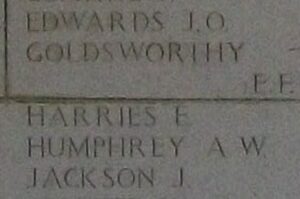
Glyn Harries, Aircraftman 1st Class, 1315784, Royal Air Force. Glyn was the son of Thomas and Katherine Harries, of Pontarddulais, and the husband of Reta P. Harries, of Guelph, Canada, who he had met and married while serving in Canada. He enlisted into the Royal Air Force, and was sent to Canada to train with the Empire Air Training Scheme. Glyn was killed when his plane crashed in Canada on 6 March 1944. He was 22 years old, and is buried in section 8, block P, grave 42 of Guelph (Woodlawn) Cemetery, Canada.
Melvyn D. Harry, Private, Welch Regiment. Melvyn was born in Penclawdd in 1924. He had served during the war with the Welch Regiment, and died after discharge, on 2 October 1946, aged 22. He is buried in Parc Hendy Cemetery, Penclawdd. Melvyn is not commemorated by the CWGC.
Gwyn Humphrey Hughes, Private, 6085206, The Queen’s Royal Regiment (West Surrey). Gwyn was the son of Thomas David and Rebecca Hughes, of Loughor. He served with the 2nd Battalion, West Surrey Regiment. The battalion was in Palestine at the outbreak of war, and was readying for a move to Egypt when Gwyn was killed on 24 December 1939, aged 26. He is buried in grave D. 18 in Ramleh War Cemetery, Israel.
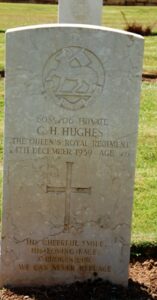
William Handel Hughes, Second Radio Officer, Merchant Navy. William was born on 16 December 1916, the son of Mr. and Mrs. James Hughes, of Pontarddulais. He lived at Dynevor House, 61, Bolgoed Street, Pontarddulais. William served in the Merchant Navy aboard the SS Wayfarer, a London registered cargo ship. On 19 August 1944 she was en-route from Colombo for Britain with a cargo of copper, when she was torpedoed and sunk by German submarine U-862, about 90 miles from Mozambique. William was 27 years old when he died that day, and is commemorated on panel 117 of the Tower Hill Memorial, London.
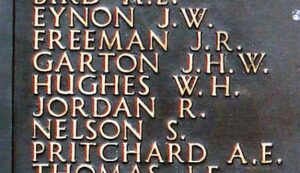
David Brinley Isaac, Lieutenant, 156414, Durham Light Infantry. David was the son of Sidney Isaac and Margaret Isaac (nee Edwards), of Dunvant, Glamorgan. He was commissioned into the South Wales Borderers in November 1940 and married Christine Pelegie Moore, of Dunvant, in 1941 prior to embarking for North Africa. On 18 March 1942 he was transferred to the Royal Welsh Fusiliers, but was seconded to the 6th Battalion, Durham Light Infantry, which had been in North Africa with the 50th Division since leaving Britain on 23 May 1941. David joined the battalion in time to take part in the Second Battle of El Alamein during October and November 1942. The 50th Division returned to the front line when the Eighth Army reached the Mareth Line in February 1943. On the night of 20/21 March the 6th DLI followed up an attack by its sister battalions, the 8th and 9th, against an Italian Division, and on 22 March 1943 advanced through the battalions, accompanied by tanks. The Germans counterattacked with the 15th Panzer Division that day and the 6th Battalion suffered heavy casualties. David was among those killed during the desperate defensive action of 22 March 1943. The 23-year-old has no known grave and is commemorated on face 19 of the Medjez-El-Bab Memorial, Tunisia.
William Glenmor Jeffreys, Leading Airman, FAA/FX. 78108, Royal Navy. William was born in the Gower early in 1919, the son of Robert Jeffreys and Florence Jeffreys (nee Williams). Upon leaving Gowerton School he enlisted into the Royal Navy, and was posted to the Fleet Air Arm base, HMS Daedalus. He was among 142 members of the Fleet Air Arm sent to Liverpool in order to sail to RNAS Piarco, on Trinidad, and boarded the former Blue Star passenger liner SS Almeda Star, which sailed from Liverpool on 15 January 1941. On the following day the German submarine U-96 sunk the passenger liner Oropesa in the Western Approaches, killing 106 of the people aboard and remained in the area waiting for her next victim. At 07.45 on 17 January 1941 Almeda Star was about 35 miles north of Rockall in heavy seas when U-96 struck her amidships with one torpedo, causing Almeda Star to stop. Almeda Star managed to launch four lifeboats, but still had people on deck when U-96 fired two more torpedoes into her before surfacing and opening fire with her deck gun. Although the shelling set the stricken ship ablaze, a fourth torpedo was required to eventually sink her at around 09.58. A distress call had been sent out and the Royal Navy who despatched seven destroyers, but no trace was found of the ship or any survivors. William was among 360 people lost in the tragic sinking. He was 22 years old and is commemorated on bay 2, panel 2, of the Lee-on-Solent Memorial, Hampshire.
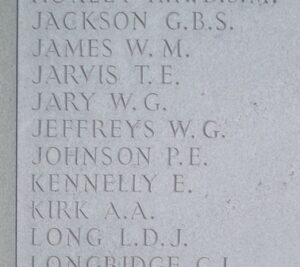
William Rees John, OBE, Wing Commander, 73769, Royal Air Force Volunteer Reserve. William was born in Bancyfelin in 1892, the son of William John, GWR Stationmaster, and Adalide John. By 1901 his father had become Stationmaster at Loughor. William had studied for the Admiralty prior to the Great War, and served with the Royal Navy throughout the conflict. He became the Assistant Superintendent of the Madras Police after the war, and was awarded the King’s Police Medal for gallantry in the 1924 New Year’s Honours List. He served for 21 years in Indian Police Training School, Vellore, before returning to Britain to join the Royal Air Force and setting up home with his wife Gwladys Jane John, at Gorseinon. He was attached to the Provost Marshal’s Department of the Air Ministry and was appointed OBE on 8 June 1944. William died in Richmond, Surrey on 25 April 1946, aged 55, and is buried in row 4, grave 3 in Gorseinon (Brynteg) Congregational Chapelyard. His brother Freddie was killed in WW1.
George Leeson Jones, Flight Lieutenant, 127237, Royal Air Force Volunteer Reserve. George was the son of William James Jones and Mildred Elizabeth Ann Jones, of Swansea. He was commissioned into the Royal Air Force Volunteer Reserve on 5 August 1942 and trained as a pilot before being posted to 207 Squadron, Royal Air Force, which was equipped with the Avro Lancaster, based from October 1943 at RAF Spilsby. On the night of 15 July 1944 George took off from Spilsby aboard Lancaster ME807, which was part of a large force despatched to bomb railway yards at Nevers and Châlons sur Marne. At around 03.00 on the morning of 16 July 1944 George’s Lancaster collided with Lancaster ME851, before crashing and exploding in flames at Marnay in the Commune of Lignieres, killing the entire crew of both aircraft. George, who was 30 years old, is buried alongside his comrades in row B, grave 1, in Lignieres-De-Touraine Communal Cemetery, France.
Hilton James Jones, Flight Sergeant, 965692, Royal Air Force Volunteer Reserve. Hilton was the son of Mabel Jones, of Pontarddulais, and he served with 220 Squadron, RAF. The Squadron flew with Coastal Command, equipped with the Lockheed Hudson. In April 1941 the squadron as a whole moved to Wick in Scotland, where it continued to operate on anti-shipping duties over Norwegian waters. Hilton was killed on 19 October 1941 when his Hudson did not return from a flight to Norway and was presumed to have come down in the sea. He was 20 years old, and is commemorated on panel 36 of the Runnymede Memorial, Surrey.
Brinley Howard Lewis, Private, 3911446, South Wales Borderers. Brinley was the son of Jenkin and Polly Lewis, of Pontarddulais. He married Pearl Louisa Howells, of Llangennech, in 1941, prior to embarking for Burma with the 6th Battalion, South Wales Borderers. The Battalion was raised in Glanusk Park, Breconshire, in July 1940 as an infantry unit, but converted to a tank regiment, the 158th Regiment Royal Armoured Corps, and sailed for Bombay in October 1942. It was converted back to an infantry unit in March 1943, and trained as an amphibious assault unit before moving to Burma to fight in the Arakan, where it famously captured the Mayu Tunnels in March 1944. After an arduous campaign, on 5 August 1944 the 6th Battalion, SWB took part in an attack on a strongly defended Japanese position at Hill 60, by the village of Sahmaw Chaung, and suffered heavy casualties in the attempt to take the position. Brinley was 27 years old when he was killed that day, and is buried in grave 6. F. 20. in Taukkyan War Cemetery, Myanmar.
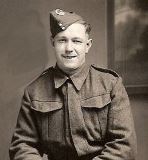
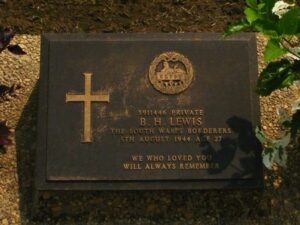
John Idris Lewis, First Radio Officer, Merchant Navy. John was born in Loughor on 26 March 1898, the son of John and Sarah Lewis. The family later resided at Tegryn House, Princess Road, Gorseinon. John enlisted into the Merchant Navy and trained as a radio officer before being posted aboard the Glasgow registered Clan-line steamer, SS Clan MacWhirter. She had traded un-escorted in the Indian Ocean and South Atlantic for the first year of the war before returning to Britain and taking part in several convoys, mostly to African destinations. Sailing from Karachi via Cape Town, she arrived at Bathurst, Gambia, on 14 August 1942, carrying a cargo of manganese, linseed and pig iron before sailing for Hull with Convoy SL 119. Clan McWhirter suffered engine trouble on 20 August and began falling behind the convoy. On 27 August 1942 she was torpedoed by the German submarine U-156 off Madeira and sank with the loss of eleven lives. Before she sank, several life-boats were launched, and 67 crew and 7 DEMS gunners were later picked up alive. John was 42 years old when he was killed in the sinking on 26 August 1942. He is commemorated alongside his ship-mates on panel 30 of the Tower Hill Memorial, London.
Edgar Charles Prytherch Lloyd, Sergeant (Pilot), 1293920, Royal Air Force Volunteer Reserve. Edgar, known as Garry, was the son of Arthur and Olwen Lloyd, of Swansea. He married Joan Senior, of Sheffield, while based in Yorkshire with 50 Squadron, Royal Air Force. The squadron was based at RAF Skellingthorpe, equipped with the Avro Lancaster. At 22.47 on the night of 7 July 1944, Edgar took off from Skellingthorpe flying Lancaster DV227, bound for a V2 launching site at St-Leu-d’Esserent. At around 02.05 on the morning of 8 July 1944 the Lancaster was intercepted by a German night-fighter and shot down near Rederie, some 5km from Granvilliers, killing all her crew. Edgar was 25 years old when he died during the crash, and is buried alongside his fellow crew-men in joint grave 4 at Moliens Communal Cemetery, France.
David Brian Long, Aircraftman 2nd Class, 1281983, Royal Air Force Volunteer Reserve. David was the son of Evan John Long and Sarah Long (nee Austin), of Three Crosses, Glamorgan. He married Elsie Maud, of Three Crosses, prior to embarking for Malta after joining the Royal Air Force Volunteer Reserve. David worked at RAF Luqa, one of Malta’s chain of three airfields plus three satellite airfields on the island. At 18.15 on 21 December 1941 six German bombers approached Malta from the north and dropped their 500kg bombs in the Mosta-Naxxar-Gharghur area and in the sea. David was the sole military casualty of the raid, being drowned in the confusion. He was 19 years old when he was killed that day, and is buried in the Protestant section, plot F, grave 62, in Malta (Capuccini) Naval Cemetery.
John Humphrey Martin, Corporal, 568015, Royal Air Force. John, known as Jack, was the son of Frederick William and Hilda Martin, of Seacroft, Murton, Bishopston. He enlisted into the Royal Air Force and was posted to 201 Squadron, Royal Air Force, which was a Coastal Command unit, equipped with Saro London Mk2 Flying Boats. It re-equipped with the famous Short Sunderland early in 1941, carrying out convoy escort and Anti-submarine patrols from several bases: Sullom Voe, on the Shetland Islands; Castle Archdale, at Lough Erne, Northern Ireland; and Pembroke Dock. John was killed on operation off the west coast of Ireland on 21 December 1941, aged 22. His body was brought home, and he was buried in row 3, grave 1, of St. Teilo’s Churchyard, at Bishopston.
William Henry Mathias, Flight Sergeant, 1836211, Royal Air Force Volunteer Reserve. William was the son of Evelyn May Mathias, of Loughor. He served with 644 Squadron, Royal Air Force, which was an RAF Transport Squadron, attached to 38 Group. The Squadron took part in a multitude of operations, including supply dropping to SOE forces, and glider towing during Operation Overlord, Market Garden and Varsity. On 14 September 1945, William was a crewman aboard a Halifax VII, Serial PN305, which took off from RAF Tarrant Rushton to the Azores, with a crew of seven and fourteen passengers. The failure of an electrical system inflated a dinghy, which damaged control of the aircraft, and it dived into the ground in Cornwall, killing 21 men. William was just 20 years old when he died that day, and is buried in plot 39, section H, row F, grave 246, in Bath (Haycombe) Cemetery, Somerset.
John Raymond Madoc Michael, Second Lieutenant, 96052, Welch Regiment. John was the son of David Raymond Michael and Jennie Michael (nee Maddocks), of Frondulais, Glanyrafon Road, Pontarddulais. He was commissioned as a Second Lieutenant with the 15th Battalion, Welch Regiment, which was a Home Service battalion. John was accidentally hurt while on duty during the movement of troops in the Bridgend area and died in hospital at RAF St. Athan on 2 August 1940, aged 23. He is buried at St. Teilo’s Churchyard, Ponyarddulais, to the south of the Church.
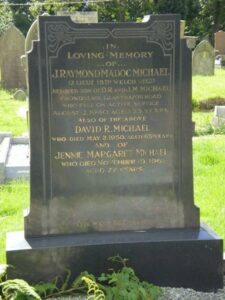
Christopher Gwyn Morgan, MC, Lieutenant, 127802, Royal Army Service Corps. Christopher was the son of Christopher and Margaret Morgan, of Penscallen, Loughor. He was commissioned into the 18th Battalion, West Yorkshire Regiment on 16 July 1915, and was awarded the Military Cross whilst serving as Acting Captain with the battalion. The citation was published in the London Gazette of 15 October 1918, and read: ‘After the objectives of an important attack had been successfully reached, Captain Morgan promptly reorganised his company and consolidated the advanced posts with great initiative. When the posts on his flank were forced to withdraw for a short distance, owing, to the heavy and persistent enemy shelling, he maintained his positions until the situation could be restored. He set a fine example to his company by his gallant and cheerful bearing throughout the whole operation.’ On 8 May 1940 he was gazetted into the Royal Army Service Corps as a Lieutenant. He contracted pneumonia while on manoeuvres at Salisbury Plain, and died in hospital in Dorset on 24 January 1941, aged 41. Christopher is buried in grave 803 in Shaftesbury Borough Cemetery, Dorset.
John Humphrey Parry, Flight Sergeant, 1669977, Royal Air Force Volunteer Reserve. John was the son of Thomas Ivor and Hannah Parry, of Loughor. He served with 178 Squadron, Royal Air Force, which was equipped with Consolidated B-24 Liberators at Shandur, Egypt on 15 January 1943. It moved to Libya, then Italy from March 1944, and was used for air drop operations in support of the besieged Polish Home Army in Warsaw in 1944. John was one of eight men killed when their Liberator was brought down while taking supplies from Italy to resistance fighters in Yugoslavia on 6 November 1944. John was 19 years old and is buried alongside his fellow crew-men in collective grave 7. B. 1-8, in Belgrade War Cemetery, Serbia.
Douglas Pewsey, Sergeant, 970469, Royal Air Force Volunteer Reserve. Douglas was the son of Thomas John and Margaret Ann Pewsey, of Loughor. He served with 44 Squadron, Royal Air Force, which was a bomber squadron, equipped with the Handley Page Hampden. On 14 November 1940, Douglas was a crewman aboard Hampden X2995, which took off from RAF Waddington to bomb targets on the continent. The aircraft stalled 800 feet off the ground and crashed a mile from the airfield, killing all her crew. Douglas was 21 years old when he died that day, and was brought home for burial at St. Michael’s Churchyard, Loughor, to the south-west of the Church.
Dudley Vaughan Phillips, MA, MRCS, LRCP, Lieutenant, 244588, Royal Army Medical Corps. Dudley was born on 4 May 1917, the son of Thomas Vaughan Phillips and Marion Eleanor Phillips, of Rose Lawn, Old Road, Llanelli. Upon leaving Gowerton School he was educated at Cambridge University, and then at St. Mary’s Hospital, before being commissioned into the Royal Army Medical Corps. Dudley was killed during an accident at the 52nd (Lowland) Division battle school in Scotland on 4 January 1943, aged 25. Dudley is buried in Section 3, Row 1, Grave 1A of Llanelli (Box) Cemetery.
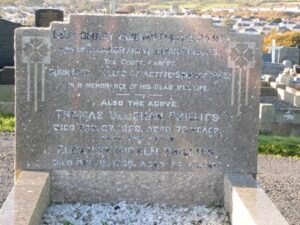
David Eynon Powell, Aircraftman 2nd Class, 1417071, Royal Air Force Volunteer Reserve. David was the son of Daniel and Mary Jane Powell, of 35, Lime Street, Gorseinon. He married Catherine Ada Beynon, of Loughor, in 1933. David enlisted into the Royal Air Force. He died on active service at Townleys Hospital, Bolton, Lancashire on 25 February 1942, aged 33. His body was brought back home for burial in section G, grave 329 of Kingsbridge Cemetery, Glamorgan.
Kenneth John Raiswell, Sergeant, 1151893, Royal Air Force Volunteer Reserve. Kenneth was the son of John Raiswell and Mabel Raiswell (nee Smith), of Gowerton, Glamorgan. He enlisted into the Royal Air Force Volunteer Reserve, and after training as a Wireless Operator/ Air Gunner, was posted to 115 Squadron, Royal Air Force, which was equipped with the Vickers Wellington III, based at RAF Marham. On the night of 13 April 1942 Kenneth took off from Marham aboard Wellington X3596, as part of a force ordered to bomb Essen. The Wellington was intercepted and shot down by a German night fighter and crashed in Lake IJsselmeer, east of the island of Urk, at around 01.00 on the morning of 13 April 1942. Kenneth and his fellow crew-men were buried in Amsterdam New Eastern Cemetery, Netherlands. Kenneth lies in grave 85. C. 13.
Talfryn John Rees, Lance Sergeant, 850091, Royal Artillery. Talfryn was the son of David Daniel and Mabel Hannah Rees, of Gorseinon, Glamorgan. He served with the 71st Anti-Tank Regiment, Royal Artillery, which was a unit made up from men of the 5th Battalion, Royal Welch Fusiliers, armed with 6pdr and 17pdr anti-tank guns, and was attached to the 53rd (Welsh) Division. The division landed on the Normandy beaches in the middle of June 1944, and the 71st Anti-Tank Regiment was put into action west of Caen. Talfryn was killed by German mortar-fire on 4 July 1944. The 26-year-old was buried in grave XIII. D. 5. in St. Manvieu War Cemetery, Cheux, France.
Evan Henry Richards, Flight Lieutenant, Royal Air Force. Evan was the son of Thomas Daniel Richards and Mary Richards (nee Thomas), of 10, Trinity Place, Pontarddulais. He served during the war as an Education Officer with the Royal Air Force. He died in hospital in Swansea on 28 August 1946, after having been invalided out of the RAF. He was 39 years old, and is buried at Rhydgoch Cemetery, Pontarddulais.
Herbert John Roseblade, Signalman, 14039301, Royal Corps of Signals. Herbert was the son of Frederick Roseblade and Katherine Roseblade (nee Evans), of Gowerton, Glamorgan. He served with the Royal Corps of Signals and was attached to the 32nd Armoured Brigade Signal Squadron. Herbert was serving in Greece, when he was drowned in an accident on 23 May 1946. The 19-year-old was buried in grave 20. D. 23. in Phaleron War Cemetery, Greece.
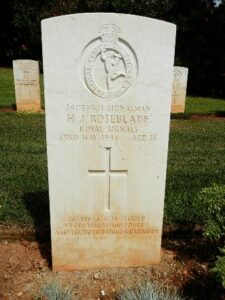
Arthur Rees Schroeder, Serjeant, 2192663, Royal Engineers. Arthur was the son of George H. and Annie M. Schroeder, of Pontarddulais. He married Irene Bunting in Middlesex in 1941, whilst based in the area with the Royal Engineers. Irene gave birth to their daughter Patricia soon after. Arthur served with 626 Field Squadron, Royal Engineers in North Africa and then in the invasion of Italy. The unit was attached to the 6th Armoured Division, and landed at Salerno on 3 September 1943, in Operation Avalanche. Arthur was killed in action while taking part in the attempt to push forwards from the Salerno beach-head on 3 September 1943. He was 22 years old, and is buried in grave VI. B. 45. in Salerno War Cemetery, Italy.
Albert John Thomas, Sergeant, 1006925, Royal Air Force Volunteer Reserve. Albert was the son of James and Ellen Beatrice Thomas, and the husband of Beryl Thomas, of Loughor. He served with 40 Squadron, Royal Air Force, which was a medium bomber squadron, equipped firstly with the Bristol Blenheim, based at RAF Wyton and moved to RAF Alconbury, after re-equipping with the Vickers Wellington, in February 1941. Albert was killed when his Wellington was lost over Nuremberg on 15 October 1941. He was 25 years old and is commemorated on panel 53 of the Runnymede Memorial, Surrey.
David Glynn Thomas, BA, Captain, Royal Marines. David was the son of John and Caroline Thomas, of Loughor. He married Elinor Annie Adams, of Loughor in 1942. David had graduated with BA (Honours) prior to the war, and was commissioned into the Royal Marines. He served with 602 Landing Craft (Mechanised) Flotilla. On 25 June 1944 David was aboard the SS Cap Tourane, which was anchored off Sword Beach, being used as the HQ ship, when the ship was hit by a German shell. David and a fellow officer were killed. David was 31 years old, and is buried in grave 1. R. 15. in Hermanville War Cemetery, France.
Douglas Arthur Gwynne Thomas, Sergeant, 1446824, Royal Air Force Volunteer Reserve. Douglas was born in the Pontypridd district in 1912. He enlisted into the Royal Air Force Volunteer Reserve and was posted to 405 Squadron, Royal Canadian Air Force, an elite Pathfinder unit which came under command of the Royal Air Force. Equipped with the Vickers Wellington, Handley Page Halifax and the Avro Lancaster, 405 Squadron was tasked with laying flares or incendiary bombs on targets, which the main bomber formations could use as guidance. On the night of 2 August 1943, Douglas took off from RAF Topcliffe aboard Halifax II, Serial HR917, as part of a large force despatched to bomb Hamburg. The aircraft went missing on the following morning, on 3 August 1943. Douglas and his fellow crew-men were later declared as having been killed on 3 August 1943. Douglas was 31 years old when he died that morning, and is commemorated on panel 167 of the Runnymede Memorial, Surrey.
Ivor Llewellyn Thomas, Sergeant, 580177, Royal Air Force. Ivor was the son of George Ivor Thomas and Annie Maria Thomas (nee Jeffreys), of Llanrhidian. He was a Pilot with the Royal Air Force prior to the war and married Joyce Evelyn Berry whilst station with the Royal Air Force in the Huntingdon area in 1939. Ivor served with 40 Squadron which operated Bristol Blenheim Mk IV light bombers from RAF Wyton from December 1939. At 15.44 on 10 May 1940 Ivor took off from Wyton flying Blenheim L8831, ordered as part of a flight to bomb Ypenburg Airfield. His aircraft was shot down by a German fighter and crashed between Uithoflaan and Wennetjessloot at Wateringen, near The Hague, Holland, killing 24-year-old Ivor and his two crew-men. The three men are buried in The Hague (Westduin) General Cemetery, Netherlands. His brother Albert George Thomas also died on service.
Owen Goronwy Thomas, Leading Writer, D/MX 105408, Royal Navy. Owen was born in Loughor on 23 January 1908, the son of Thomas and Elizabeth Thomas. His parents moved to Martley, Llandyssul at some time after the war. Owen married Doris Cordelia Morris of Llanelly in 1936. He enlisted into the Royal Navy and served aboard the Dido Class destroyer HMS Charybdis. She was sent to sea in the English Channel on 23 October 1943 as part of a number of vessels to intercept the German supply ship Munsterland. Charybdis was attacked and sunk by a squadron of German torpedo boats that day, with the loss of over 400 men. Owen was 35 years old, and is remembered on panel 83, column 1 of the Plymouth Naval Memorial, Devon.
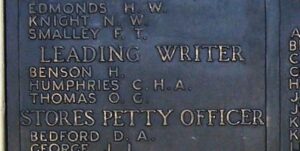
Thomas James Glyndwr Thomas, Flight Sergeant, 615005, Royal Air Force. Thomas was the son of William and Nellie Thomas, of Loughor. He married Elizabeth Doreen John, of Gorseinon, in 1940. He served with the Royal Air Force as a Wireless Operator/ Air Gunner. Thomas was killed on 14 January 1943 while flying aboard Handley Page Halifax W7844, which lost control and crashed while on a training flight near Kemble, Gloucestershire. He was 24 years old, and is buried in section A, grave 287 in Kingsbridge Cemetery, Glamorgan.
Robert George Thorne, Flight Sergeant, 1266197, Royal Air Force Volunteer Reserve. Robert was the son of Theophilus Marmaduke Thorne and Emily Maud Thorne (nee Dudden), of Cwmdu, Swansea. He enlisted into the Royal Air Force Volunteer Reserve and was posted to 7 Squadron, Royal Air Force, which was a pathfinder unit, equipped with the Short Sterling heavy bomber, based at RAF Oakington. On the night of 8 March 1943 Robert took off from Oakington aboard Sterling I, Serial BK610, as part of a large force despatched to bomb Nuremburg. Robert was killed when his Sterling went missing on the following morning of 9 March 1943, with the loss of all her crew. The 21-year-old has no known grave and is commemorated on panel 139 of the Runnymede Memorial, Surrey.
Griffith Trevor Watkins, Warrant Officer, 1316918, Royal Air Force Volunteer Reserve. Griffith was the son of Griffith Watkins and Gertrude Ann Watkins (nee Larkworthy), of Jeppe, Danybryn Road, Gorseinon. He enlisted into the Royal Air Force Volunteer Reserve and was posted to 203 Squadron, Royal Air Force, which was originally a flying boat squadron, equipped with the Short Singapore flying boat, and moved to Aden shortly after the outbreak of war. In December 1940 it began re-equipping with the Bristol Blenheim, and in April 1941 helped to provide fighter cover for ships evacuating British and Allied troops from Greece, using bases on Crete. From May 1941 part of the squadron operated from the base at Habbaniya, Iraq, while the bulk of the squadron operated from bases in North Africa, flying patrols over the Mediterranean. The squadron re-equipped with the Martin Maryland then the Martin Baltimore in 1943, before moving to India in November 1943, where it converted to the Vickers Wellington and began to fly coastal patrols. In October 1944 the Wellingtons were replaced with Liberators and in February 1945 the squadron began to fly anti-submarine patrols over the Bay of Bengal. Griffith was on such a patrol when his Wellington was attacked by Japanese fighters and was forced down into the sea near Sebise Island on 13 August 1945, killing the entire crew. Griffith was 21 years old when he died that day and is commemorated on column 449 of the Singapore Memorial, Singapore.
Leslie Alexander Williams, Sergeant, 1897783, Royal Air Force Volunteer Reserve. Leslie was the son of Emrys Williams and Louisa Williams (nee Richards), of Pontarddulais. He married Edith Davies, of Pontarddulais, in 1942. Leslie had enlisted into the Royal Air Force Volunteer Reserve and after training as an Air Gunner was posted to 61 Squadron, Royal Air Force, which was a heavy bomber squadron, equipped with the Avro Lancaster, and based at RAF Skellingthorpe. On the night of 4 January 1945 Leslie took off from Skellingthorpe aboard Lancaster PA165 which had been despatches as part of a force to bomb German supply routes in the Ardennes. On the morning of 5 January 1945, the Lancaster was over the target area, in the vicinity of Houffalize, Belgium, when it was shot down and crashed, killing all but one of her crew. Leslie is buried in grave 8. F. 6. in Hotton War Cemetery, Netherlands, alongside five of his fellow crew-men. The one survivor, Wireless Operator McKay was taken prisoner.
Philip William Williams, Warrant Officer, 1375918, Royal Air Force Volunteer Reserve. Philip was the son of Watkin and Annie Williams, of Loughor. He enlisted into the Royal Air Force Volunteer Reserve and after training as a Wireless Operator/Air Gunner was posted to 353 Squadron, Royal Air Force, which had formed at Dum Dum on 1 June 1942 with three Lockheed Hudsons. The squadron carried out patrols over the Bay of Bengal, before swapping to transport duties, equipped with their Hudsons, and then by the addition of a number of Douglas Dakotas. On 17 August 1945 Philip was flying aboard a Dakota III, Serial FL603, which had taken off from Santa Cruz, Bombay on a routine transport flight to Mauripur. While flying near Dahanu the port wing became loose and as a result the port engine failed, sending the Dakota to the ground, and killing all her crew of three as well as her six passengers. All of the casualties are buried in Kirkee War Cemetery, India. Philip, who was 32 years old, lies in grave 8. AA. 15.
Phillip Walter Winter, Leading Aircraftman, 1046282, Royal Air Force Volunteer Reserve. Phillip was the son of Walter Ernest Winter and Ruth Winter (nee Churchill). He was initially educated at Pembroke Dock School, before the family moved to Gowerton, and he continued his education at Gowerton School. Phillip enlisted into the Royal Air Force Volunteer Reserve, and was sent to Alabama, USA, as part of the Commonwealth Air Training Plan, for training. Phillip was killed in Alabama on 11 April 1942 during a flying accident. He was 20 years old, and is buried at Montgomery (Oakwood) Cemetery Annexe, Alabama, in section N, lot 111, grave 4.
Robert Graham Wright, Pilot Officer, 142491, Royal Air Force. Robert was the son of Robert and Harriet Wright, of Pontlliw. He enlisted into the Royal Air Force and trained as an Air Gunner before being posted to 76 Squadron, Royal Air Force, which had reformed at RAF Linton-on-Ouse as a Handley Page Halifax bomber squadron, as part of No. 4 Group, RAF Bomber Command. The squadron moved to Middleton St George in June 1941, returning to Linton-on-Ouse in July 1942. On the night of 29 March 1943 Robert took off from Linton-Upon-Ouse aboard Halifax II, Serial DT563, which had been despatched as part of a large formation to bomb Berlin. The Halifax was shot down over the North Sea whilst on its return journey the following morning, of 30 March 1943, killing all her crew. Robert’s body was recovered from the sea, and the 19-year-old was buried in in grave 58 in Vlieland General Cemetery, Netherlands. The remainder of the crew were all posted as missing and are commemorated on the Runnymede Memorial, Surrey.
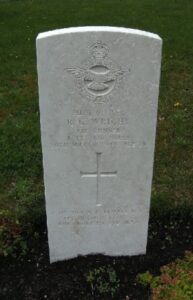
Ronald Henry Yerbury, Private, NX66145, Australian Infantry. Ronald was born on 9 June 1919, the son of Edgar Charles and Annie Catherine Yerbury, of Craig Fawr, Pontarddulais. He emigrated to Australia and enlisted at Paddington, NSW into the Australian Imperial Force on 10 July 1940. After training, Ronald was posted to No 1 Independent Company, which was an Australian Commando force, and was sent to Papua New Guinea, as part of ‘Lark Force’, a force of 1,500 men, to defend two airfields on the Island. Desperately outnumbered by an invading Japanese force of over 20,000, which landed on 23 January 1942, the Commandos fought desperately, but over the coming weeks were either killed or captured by the Japanese. Ronald was among the Australians taken prisoner, and was one of a number of POWs taken aboard a Japanese transport, the Montevideo Maru, which sailed from New Guinea on 22 June 1942, bound for Japan. Ronald died when the ship was torpedoed and sunk by the American submarine USS Sturgeon off the Philippines on 1 July 1942. He was 23 years old, and is commemorated on the Rabaul Memorial, Papua New Guinea.
